The Unseen Stage: How Backgrounds Shape What We See in Art
In art, backgrounds do far more than sit quietly behind the main subject, they set the tone, shape the story, and guide our eyes through the scene. Whether subtle or striking, backgrounds have always played a powerful role in how we experience art. This guide explores everything you need to know about them, from their structure and symbolism to their evolution across history and mediums. If you’re new to the core principles of visual art, be sure to check out our Art Fundamentals guide for essential context. There's a lot on this page, so use the jump links below to explore a section of your choosing.
Understanding the Background: More Than Just Empty Space
Ever looked at a painting and mainly focused on the main subject? It's easy to do! But the background, that space behind the main action, is a super important player in how we see and understand art.
It's like the stage for a play, but it does so much more than just sit there. We're going to explore what backgrounds do, how they've changed over time, and the cool ways artists use them.
What Exactly is a 'Background' in Art?
So, what do we mean by 'background'? Simply put, it's the "background space or setting that an image is placed within," often including "different objects and textures."1 It's everything "behind the main subjects"2 or what "exist[s] behind the main subject of a composition."3
This means the background isn't just there on its own; it's defined by its relationship to the main focus, the "focal point," of the artwork. Think of it as a supporting actor that helps the star shine, creating a visual conversation.
Sometimes, a background might just seem like a "passive backdrop."4 But it can also be an "arena of creative expression,"4 capable of "creat[ing] interesting visual effects."1
It's interesting to note that not everyone always thought of 'background' and 'foreground' the way we do now. For example, Italian Renaissance artists often saw a "dynamic network of figures (figure) surrounded by fields (campi)."5 This shows how the role of the background can be anything from just filling space to actively adding meaning.
Key Spatial Layers: Foreground, Middleground, Background, and Negative Space
To talk about space in 2D art, we often use terms like foreground, middleground, and background. These aren't about exact measurements but about how close or far things seem.6 The foreground is what's closest to you, the middle ground is in between, and the background is the furthest away.6
These areas work together to create a sense of space, whether you're looking at a small still life or a huge landscape.7
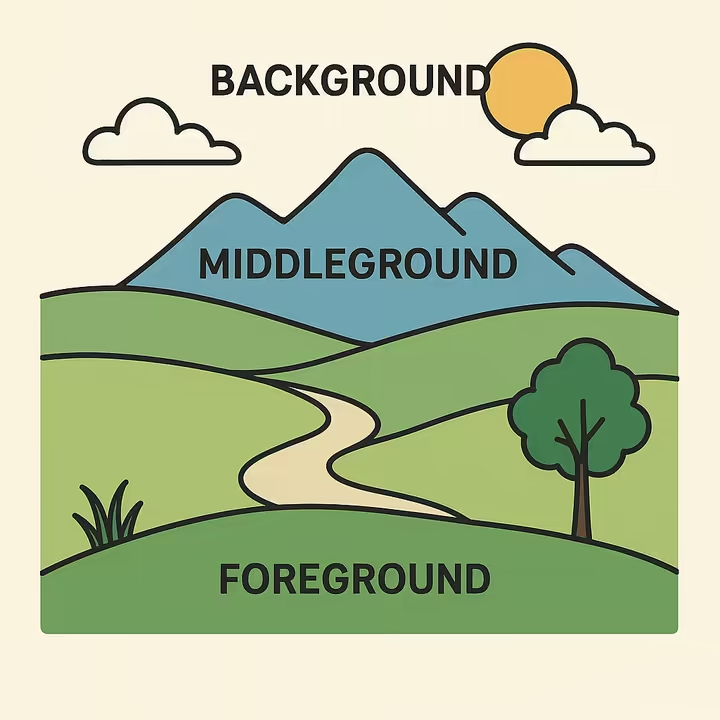
Ever heard of negative space? It's the "empty space around and between the subject(s) of an image," sometimes called "white space" or "air space."8 This space surrounds the "positive space" (the main subject) and is super important for defining the subject's shape and balancing the whole picture.8
Often, the background *is* the negative space, especially when it's a simple area that helps the main subject stand out.8 The Japanese concept of "ma" highlights the importance of this surrounding space, emphasizing the artistic relevance of the space around a subject.8
Dividing art into foreground, middleground, and background naturally creates depth and a sense of order. Negative space, which often makes up the background, helps make the subject clear and keeps the artwork balanced.
This isn't just about filling up the canvas; it’s about guiding how we see the subject and its surroundings. Plus, negative space gives our eyes a "place to rest,"8 helping us focus.
It's interesting how our common "background/foreground" labels developed over time. Back in the Italian Renaissance, artists thought more about a "dynamic network of figures (figure) surrounded by fields (campi)."4
They didn't always draw such a sharp line between subject and setting as we often do today. This shows that how we talk about and see space in art has changed throughout history.4
Why Backgrounds Are Crucial for Great Art
The background is definitely not just an afterthought; it's a "vital part of the creative process."4 It "contributes to the overall composition and context,"2 setting the scene, adding depth, and shaping how we understand the main subject.
How an artist handles the background can make or break how we see depth and distance,3 making it crucial for powerful art.3
Experts agree: the background isn't just empty space. It’s a key player in an artwork's success and meaning.2 Great artists know how to use it well, going beyond just "what's behind the subject."
Even if the main subject grabs our eye first, the background is like a "silent partner." It subtly shapes our experience,10 helping the focal point pop or even "evoke emotions that the subject alone might not achieve".4
The Many Jobs of a Background in Art
A background in art wears many hats! It does a lot to shape how we see and understand a piece.
From setting the scene and creating a sense of depth to stirring emotions and telling stories, it's a busy part of the artwork.
Setting the Scene: Time, Place, and Atmosphere
One of the background's main jobs is to give us context, telling us about the time, place, or social setting.10 Details like architecture, landscapes, or background figures' clothes can give clues.12
For instance, the shiny gold in Byzantine art immediately signals a sacred, divine subject.14 A background might also show if a person is in a professional or casual setting, telling us "more about the subject."10
Contextual backgrounds really set the stage for any story in the art. They provide the 'where' and 'when' that make the 'who' and 'what' much richer.10
Without this grounding, the subject might feel lost and the story weaker.10 Often, this info is subtle, relying on our understanding of symbols or visual cues rather than being spelled out.12
Crafting Depth: How Artists Create 3D Illusions
Perspective is a cornerstone for creating the illusion of space. Backgrounds are fundamental in this artistic endeavor, helping to create the illusion of three-dimensional space on a two-dimensional surface.3
Artists have developed and refined numerous techniques over centuries to achieve this perceptual impact.
- Linear Perspective , figured out during the Renaissance by folks like Filippo Brunelleschi and Leon Battista Alberti, uses geometry like converging lines and vanishing points. This makes things look smaller as they get further away.17 Masaccio’s The Holy Trinity and Leonardo da Vinci’s The Last Supper are amazing examples of this.17
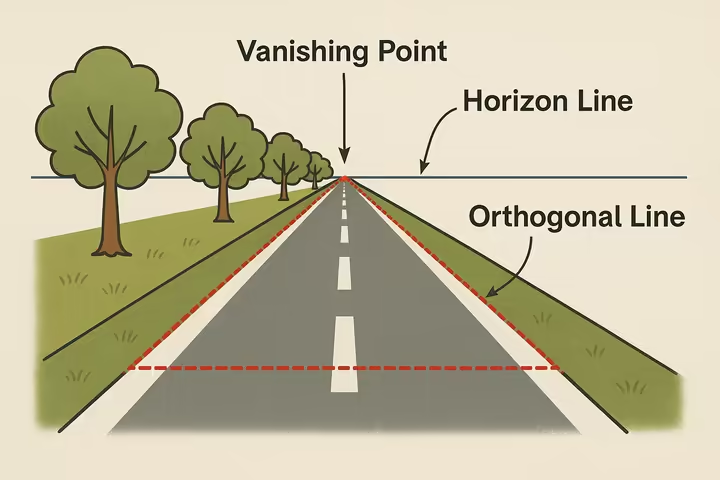
- Atmospheric Perspective (or aerial perspective) creates depth by showing how Earth's atmosphere affects distant objects. These objects look less detailed, hazier, and often cooler or lighter in color.17 It’s based on how things look different far away because of air particles.21
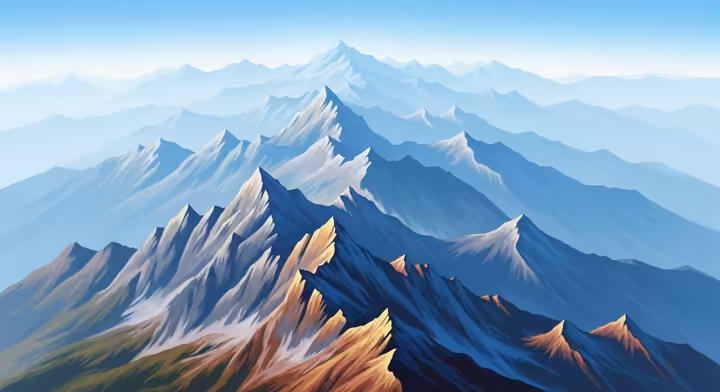
Other crucial techniques for creating depth include:
- Layering, Overlapping, and Vertical Placement: When objects overlap, the one in front looks closer.3 Often, things lower in the picture seem nearer, while higher ones look further away.15
- Diminishing Scale: This is a direct result of perspective; objects are shown smaller the further they are from us.15
- Color and Value Gradation: Smart use of color and value really boosts the 3D illusion. Lighter, less intense, or cooler colors (blues, greens) make things recede, while warmer colors (reds, oranges) seem to come forward.3 Smooth changes in color and value create a better sense of depth.10
- Detail and Texture Tapering: Artists often reduce detail and sharpness in background elements to suggest distance. Sharper details and textures bring things forward.3
The way these techniques developed, especially during the Renaissance, shows that creating depth is a clever illusion refined over time. The quest for "naturalism"17 really drove these innovations.
This means depicting deep space isn't automatic in 2D art; it’s a learned system.17
The Renaissance focus on techniques like linear perspective wasn't just about art tricks; it reflected a bigger cultural shift. People were embracing humanism, science, and a more orderly view of the world.17
The idea of a painting as a "window onto the world"19 perfectly captures this. This systematic approach to space was very different from the often symbolic, non-perspectival spaces in much Medieval art.17
Setting the Mood: The Background's Emotional Power
The background is a powerful tool for setting a specific mood and atmosphere, greatly affecting our emotional response.3 This is done through careful use of color, light and shadow, texture, and detail.
Color Psychology is key here. Different colors can spark distinct feelings; for instance, blues often feel calm, while reds can mean passion or danger.25
Warm colors like reds and yellows tend to pop out and feel energetic, while cool colors like blues and greens recede and create calm or distance.21 How saturated or light/dark these colors are also tweaks their emotional punch.
The play of Light and Shadow is also vital. Chiaroscuro, using strong light/dark contrasts, can make a background dramatic and mysterious.29
Tenebrism, an even more extreme version, uses very dark backgrounds with figures dramatically lit, creating intense theatrical effects.33 Artists like Caravaggio and Rembrandt were masters at using these to set the mood.34
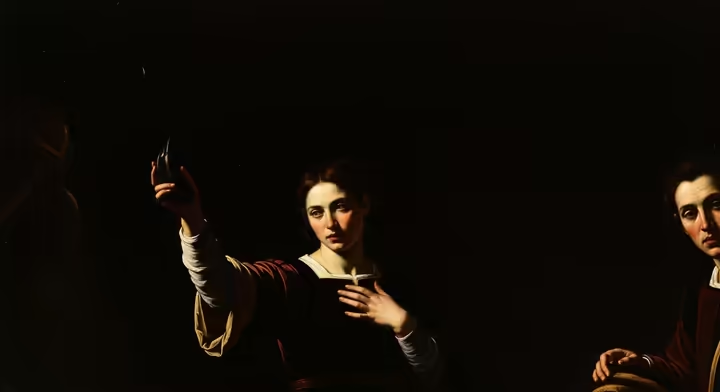
The Level of Detail and Texture in a background also shapes its feel. Softly blurred backgrounds can create a dreamy or serene mood, letting the main subject shine.37
In contrast, detailed or rough textures might suggest tension or unease.4 Less detail in the background usually makes it recede and feel calmer.22
Atmospheric Elements like haze, fog, or rain in landscape backgrounds are great for showing depth and setting a mood, whether it's melancholic, mysterious, or peaceful.22
So, the background often carries the artwork's emotional undertones. It can subtly or obviously shape how we feel about the subject, sometimes even more powerfully than the subject itself!
The background isn't just empty space; it plays a vital role in establishing the scene and mood, which is especially important in narrative art.
This shows the background isn't just passive; it actively guides our emotional journey. While some color-mood links seem universal (like blue often feeling calming25), how we interpret a background's mood can also be shaped by our culture and the time period.25
Making the Subject Shine: Contrast and Focus
A key job of the background is to make the main subject or focal point stand out and guide our eyes.3 Artists use different kinds of contrast and compositional tricks to do this.
Contrast is a major tool:
- Value Contrast: Placing light subjects against dark backgrounds (or vice-versa) creates strong emphasis, making the subject "pop".23 The spot with the biggest light/dark difference is often the main focus.23
- Color Contrast: Using complementary colors (opposites on the color wheel) between subject and background can create vibrancy and draw attention.10 Remember, warm colors advance and cool colors recede; this helps push the subject forward.23
- Texture and Detail Contrast: A simple background can highlight a detailed subject. Or, a complex background can make a simpler subject really stand out.10
Beyond contrast, framing the subject with background elements can effectively draw our eye.3 Also, lines and shapes in the background can create leading lines that guide our gaze towards the focal point or through the whole artwork.7
Through these tricks with contrast, detail, and placement, backgrounds help create a clear visual hierarchy. This shows the relative importance of different parts of the artwork, making sure our attention is managed well.40
Good background treatment often means simplifying or de-emphasizing certain areas. This ensures the main subject stays prominent and isn't lost in a "busy" background.10
So, the background's power is as much about what's *not* stressed as what *is*. It's a dynamic relationship where the background works to support the subject.
Telling Stories: Backgrounds with Meaning and Symbols
Backgrounds in art often do more than just set the scene; they actively tell stories and convey symbolic meanings that enrich our understanding.4 Let's explore this.
Symbolic Elements tucked into the background, like objects, animals, colors, or even weather, can carry layers of meaning.44 For example, in Jan van Eyck's Arnolfini Portrait, the dog in the background symbolizes loyalty and fidelity.44
A skull might be a memento mori (a reminder of death), while storms could symbolize turmoil, and rainbows can represent hope.44
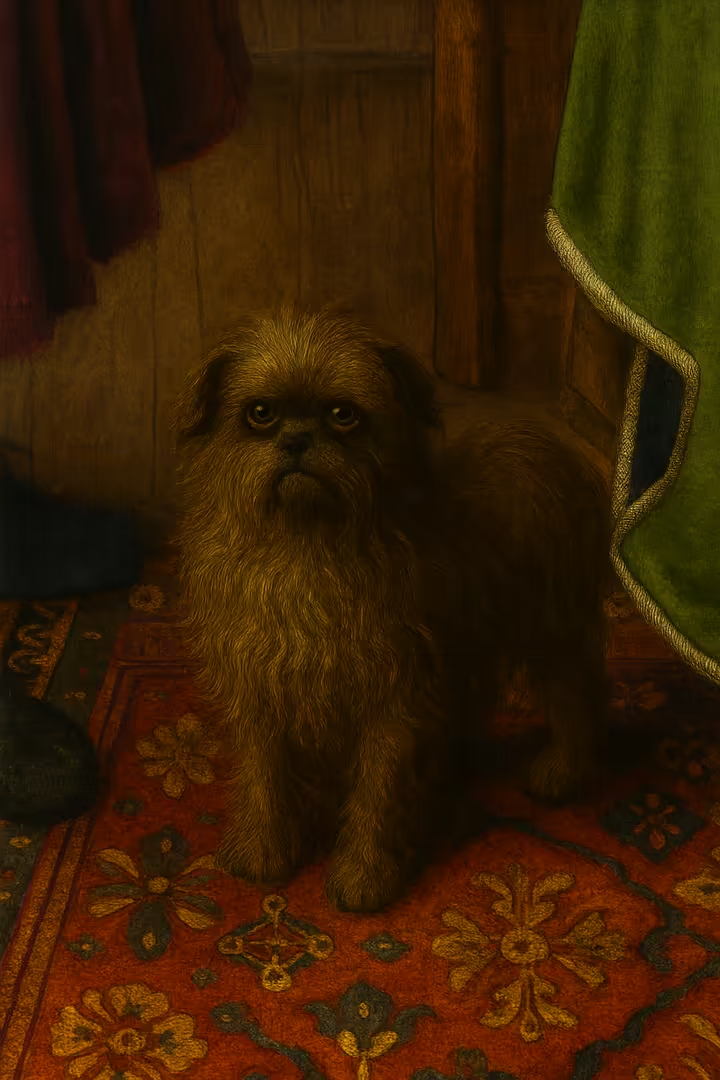
Background details can also hint at a character's personality, history, or social status, or suggest past events and future possibilities.46 A specific room can reveal someone's job, habits, or wealth.10
For instance, a cluttered scholar's study behind a portrait tells you a lot about the person.
In modern media like animation and game design, environmental storytelling is a big deal. Here, the background itself tells the story through visual and sound cues, encouraging us to explore and figure things out.49
The background can even introduce secondary stories or subplots that add to the main action. Sometimes, it might deliberately contrast with the foreground's mood or action.
This can create irony, tension, or give deeper insight, showing the sophisticated storytelling power of these seemingly secondary spaces.
A Journey Through Time: How Backgrounds Have Evolved
How artists have treated backgrounds in art has changed dramatically over the centuries. These shifts often mirror bigger changes in what cultures valued, what artists wanted to say, scientific discoveries, and new technologies.
From the symbolic backdrops of ancient times to the immersive digital worlds we see today, backgrounds have always reflected and shaped art.
Ancient Beginnings: From Symbols to Early Environments
In Ancient Egyptian art, backgrounds were usually flat and symbolic, not really trying to show realistic depth.53 Compositions were often set up in rows, with figures sized by importance, not by how far away they were.53
Hieroglyphs, simple pictures of places, and symbolic colors (like blue for fertility) often made up the background.54 These were more about giving information than creating a real-looking space.53 The goal was often religious or magical, needing clear symbolic info.53
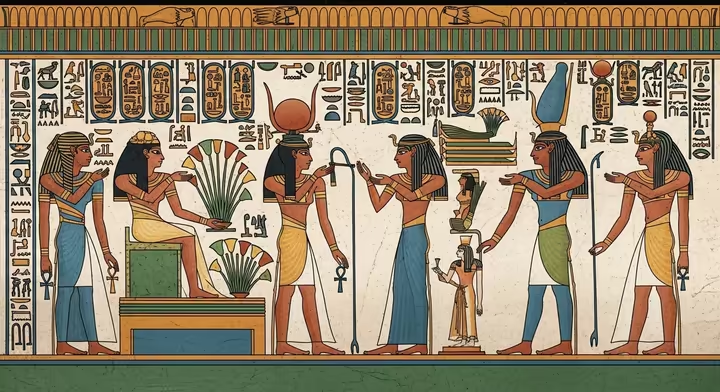
Ancient Greek art, especially in vase painting, showed an evolution. Early geometric patterns gave way to black-figure (black figures on red clay) and then red-figure (red figures on a black background) techniques.56
In both, the background mainly helped the figures stand out, with little attempt at deep space.56 Sculptures and early murals also often had plain backgrounds to highlight the figures.56
Roman art, greatly influenced by the Greeks, got more sophisticated with backgrounds, especially in murals. The Four Styles of Pompeian wall painting really show this development 59:
- The First Style (c. 200–60 BC) painted stucco to look like fancy marble, treating the wall as a surface, not a window.
- The Second Style (early 1st century BC) was a big shift towards illusion. Artists used shading and perspective to create fake architecture and vast landscapes that seemed to open up the walls.59 This was a key step towards later Renaissance ideas.
- The Third Style (c. 20 BC–AD 20) reacted against this, preferring flat decoration. Backgrounds were often single colors with delicate details and small scenes.59
- The Fourth Style (c. AD 20–79) mixed the illusion of the Second Style with the decoration of the Third, bringing back big narrative scenes and panoramic views.59
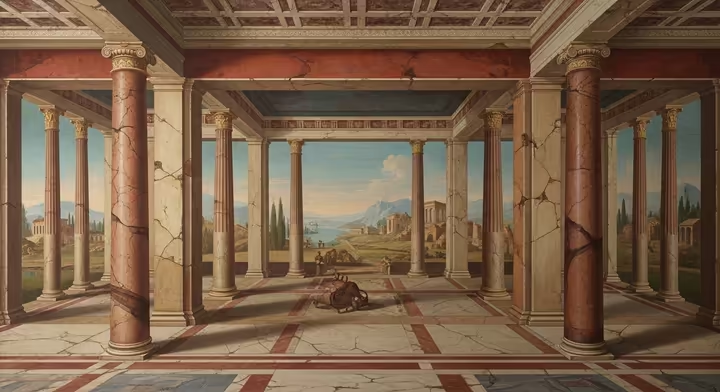
The Medieval Canvas: Divine Light and Symbolic Spaces
Medieval art, mostly serving religious aims, packed backgrounds with deep spiritual and symbolic meaning.
Byzantine art is famous for its brilliant gold backgrounds in mosaics and icons.4 This wasn't just pretty; gold symbolized divine, eternal light, turning the art into a sacred, otherworldly space.61 Figures were often stylized and flat against these glowing grounds, focusing on spiritual expression over realism.62 The gold itself, costly and pure, reflected divine perfection.60 Imagine that gold shimmering in candlelight – it created a heavenly vibe!63
Romanesque art (c. 1000 AD to 12th century) continued to use backgrounds for symbols and stories.
- In frescoes and illuminated manuscripts, any landscape elements were usually abstract decorations, not realistic nature scenes.68 Compositions had little depth, and figures were sized by their religious or social rank.68
- Church frescoes often had backgrounds divided into bold, contrasting color zones.69 The church's architecture itself often shaped how frescoes were composed and their backgrounds treated.68
- Romanesque manuscripts frequently used golden backgrounds and intricate patterns.71 Colors were vivid, making figures seem to "pop-out."71
Gothic art (c. 1150 to late 16th century) brought big changes to backgrounds, especially in stained glass and manuscripts.
- In stained glass windows, backgrounds evolved a lot. Early Gothic windows often used deep blue or ruby red backgrounds.74 Abbot Suger's influential blue might have symbolized divine light or human ignorance compared to God's light.74 As windows got bigger, backgrounds used lighter grisaille (grey) or white glass to let in more light, making colored figures stand out.75 In Gothic cathedrals, light itself, filtered through colored glass, became a vital part of the "background," creating mystical spaces.75
- Gothic illuminated manuscripts had decorative page frames, often with ivy leaves.72 Gold leaf was still widely used for backgrounds. While perspective was generally flat, there was a trend towards more naturalism by the mid-14th century.72
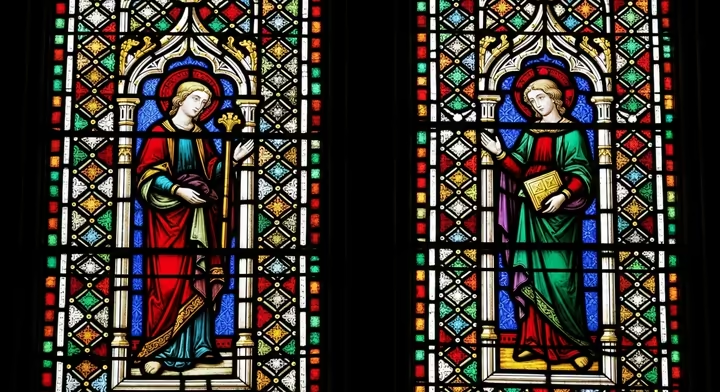
The Renaissance Revolution: Perspective, Landscape, and Atmosphere
The Renaissance was a game-changer for backgrounds in Western art. Artists moved decisively from flat, symbolic medieval backgrounds to more realistic and "earthly settings."4
Portrait artists, for example, started painting people in detailed home interiors or against vast landscapes instead of plain dark backgrounds.5 New ideas, a growing interest in nature, and amazing technical breakthroughs fueled this shift.
The development of perspective was key:
- Linear Perspective, figured out by artists like Filippo Brunelleschi and Leon Battista Alberti, gave a mathematical way to create a convincing 3D illusion. This system, using lines converging at vanishing points, allowed artists to paint spaces with incredible realism.17 Masaccio's The Holy Trinity (c. 1425-27)18 and Leonardo da Vinci's The Last Supper (c. 1495-1498)17 are prime examples. This math-based approach to space reflected the era's scientific curiosity.
- Atmospheric Perspective (or aerial perspective) helped by making distant things look less clear, less saturated in color, and often cooler or bluish, just like how atmosphere affects our view.17 Leonardo da Vinci was a master of this, as seen in his paintings' distant landscapes.17
The sfumato technique, famously used by Leonardo, involved soft, subtle blending of colors and tones, creating a smoky or hazy look. This was great for atmospheric landscape backgrounds and soft, lifelike faces, like in the Mona Lisa.17
During the Renaissance, the landscape background became much more important. It went from a simple backdrop to what's been called "pictorial real estate," giving artists new ways to tell stories and explore nature's beauty.4
Leonardo da Vinci's Mona Lisa has one of art history's most famous backgrounds. Its imaginative, somewhat mysterious landscape isn't a real place but a carefully crafted scene that fits with the sitter.78 The sfumato and aerial perspective create amazing depth and atmosphere. Many see this landscape as more than just a setting; it's viewed as a psychological landscape, reflecting Mona Lisa's enigmatic presence, making the background a key part of the painting's mystery.5
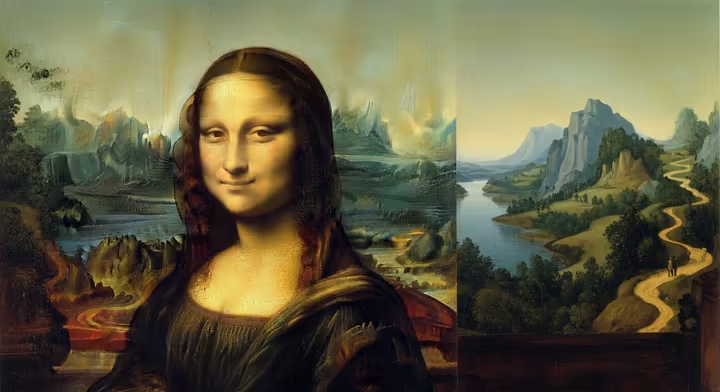
Baroque Drama and Rococo Elegance: Light, Ornament, and Theatricality
After the High Renaissance, backgrounds continued to evolve. The Baroque era brought drama and energy, while the Rococo period favored lightness and fancy decoration.
Baroque art (c. 1600-1750) is known for its dramatic intensity, rich colors, and expert use of light and shadow (chiaroscuro).35 Backgrounds in Baroque paintings often ramped up this drama. Artists frequently used dark, shadowy backgrounds to make brightly lit subjects in the foreground pop with amazing clarity.
Tenebrism, a super dramatic form of chiaroscuro with stark contrasts between lit figures and very dark backgrounds, was a signature of artists like Caravaggio.34 In his works like The Calling of St. Matthew, the background is often deep shadow, focusing all attention on the lit figures and the key moment.35 This was like theatrical spotlighting, guiding the eye and boosting emotion.34 Dutch Baroque painters like Johannes Vermeer, though often subtler, also masterfully used light to illuminate interiors, with backgrounds showing careful attention to texture and light, as in Girl with a Pearl Earring.35
Rococo art (early to late 18th century) came as a reaction to Baroque's grandeur. It's all about lightness, elegance, and lots of curvy, natural forms (like shells), asymmetry, and soft pastel colors, ivory, and gold.83
- In Rococo painting, by artists like Watteau, Fragonard, and Boucher, backgrounds often showed lighthearted myths, romantic scenes (fêtes galantes), and ideal country landscapes.83 These were painted with delicate brushwork and soft colors, creating an atmosphere of leisure and fantasy.83 The backgrounds perfectly matched the playful themes.
- Rococo interior decoration heavily influenced backgrounds. Walls and ceilings were adorned with delicate scrolls, shell shapes, and natural ornaments. Mirrors were used a lot to make spaces feel open and light.83 The background became an immersive, pleasurable environment.
Neoclassical Austerity: Idealized Clarity and Ordered Space
Popping up in the late 18th century, Neoclassicism was a strong reaction against Rococo's fluffiness and Baroque's drama.87 Inspired by newly rediscovered ancient sites like Pompeii and Enlightenment ideas of reason, Neoclassical artists wanted to bring back the forms and values of classical Greek and Roman art.
Backgrounds in Neoclassical painting were key to its goals of clarity, moral lessons, and timelessness:
- Clear Forms and Lines: Neoclassical painters valued line over color, with well-defined forms and precise drawing.87 Backgrounds used strong horizontal and vertical lines for stability and order.87
- Sober Colors and Smooth Surfaces: Colors were generally subdued, avoiding Rococo's bright hues.87 Brushstrokes were often invisible for a perfectly smooth finish.87
- Shallow Space: Compositions often had shallow space, with figures arranged like a frieze against relatively simple architectural or landscape settings.87 This was different from Baroque's deep, dynamic scenes.
- Historically Correct Settings: A big feature was meticulous historical accuracy in costumes, architecture, and details from ancient times.89 This gave scenes an air of authenticity.
- Moral Purpose: Artists like Jacques-Louis David used these carefully built backgrounds as stages for stories, often from Roman history, to celebrate virtues like patriotism and self-sacrifice.87 In David's Oath of the Horatii (1784), the stern Roman arcade in the background highlights the seriousness of the oath, reinforcing the painting's moral message.89 The background was a vital part of Neoclassicism's moral and ideological mission.
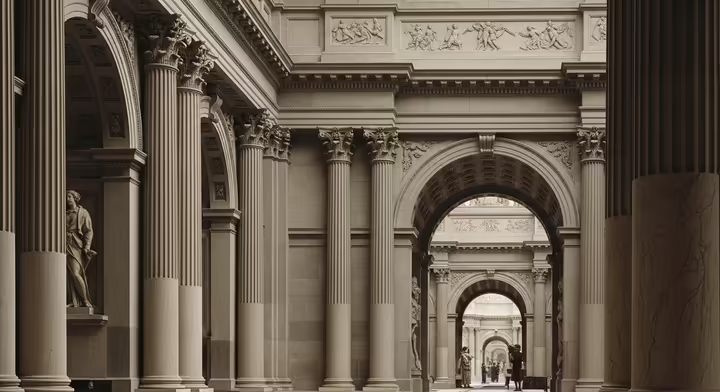
Modernism's Big Changes: Backgrounds Reimagined
Modernism, from roughly the 1860s to the 1970s, brought a radical break from old art rules, and how backgrounds were treated was central to this change.91 Artists increasingly focused on personal vision, emotion, and the art itself, leading to new ways of seeing pictorial space.
- Impressionism: Artists aimed to capture fleeting light and atmosphere, often painting outdoors (en plein air) with pure, unmixed colors.91 In Impressionist art, the line between subject and background often blurred, as both dissolved into an overall impression of light and color. The background became part of the momentary scene, like in Claude Monet's Impression, Sunrise or his Water Lilies.92
-
Post-Impressionism: This group of artists, influenced by Impressionism, pushed further to explore symbolic content, structure, or intense emotion.91
- Vincent van Gogh used swirling brushstrokes and bold, non-natural colors in his backgrounds to show his inner feelings, like in Starry Night (1889), where the sky becomes a cosmic drama.96
- Paul Cézanne broke down landscapes into geometric forms, flattening space so background and foreground interlocked, paving the way for Cubism.96
- Paul Gauguin used simplified shapes and flat areas of symbolic color in his backgrounds, often inspired by non-Western art.96
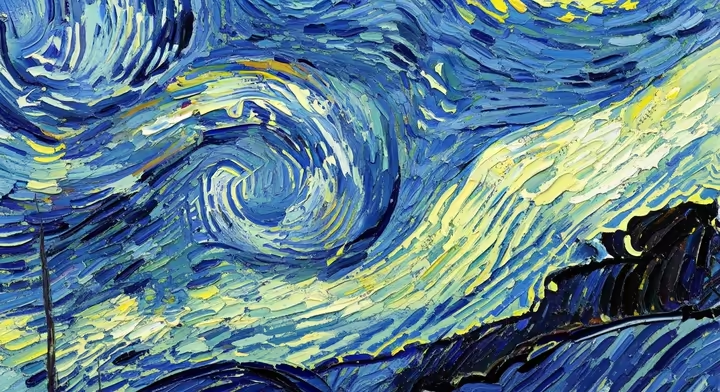
- Fauvism: Led by artists like Henri Matisse, Fauvism ("wild beasts") used intense, non-natural colors in subjects and backgrounds to express emotion and create vibrant compositions.91 In Matisse's Green Stripe (Portrait of Madame Matisse) (1905), the background is bold, flat planes of color that interact with the figure's unconventional colors.100
- Expressionism: Artists used distorted forms, jagged lines, and jarring colors in backgrounds to convey inner turmoil and anxiety.91 The background often mirrored the figure's psychological state, like in Edvard Munch's The Scream (1893), where the blood-red sky intensifies the figure's anguish.105
-
Cubism: Pioneered by Picasso and Braque, Cubism shattered traditional perspective by breaking objects and space into geometric facets, often merging background and foreground and stressing the canvas's flatness.91
- Analytic Cubism (c. 1908-1912) dissected objects and space into overlapping planes, usually in muted colors, making background and foreground hard to tell apart.108
- Synthetic Cubism (c. 1912-1914) added collage elements like newspaper, further flattening space and blurring representation and reality.108
- Surrealism: Artists explored dreams and the irrational. Surrealist backgrounds often showed bizarre, dreamlike landscapes and illogical scenes.91 Salvador Dalí famously placed melting clocks in vast, empty desert landscapes.114 René Magritte used realistic backgrounds for puzzling situations.111
-
Abstract Expressionism: This post-WWII American movement often ditched traditional background-foreground distinctions, treating the whole canvas as a unified field.91
- In Action Painting, like Jackson Pollock's "drip" works, the canvas was an "arena in which to act," with paint covering the entire surface, making a recessive background irrelevant.115
- In Color Field Painting, artists like Mark Rothko used large expanses of color to envelop the viewer, merging "background" and "foreground" into resonant color fields.115
Modernism systematically took apart traditional picture space. The background changed from a stable, recessive area to an active, fragmented, or entirely non-representational field.
In many cases, especially with Expressionism or Surrealism, the background (or the whole canvas) became a direct mirror of the artist's inner world.
Today's Art: Hyperrealism, Conceptual Ideas, and Digital Worlds
Contemporary art keeps pushing the boundaries of what backgrounds can do, using new tech and ideas while also revisiting old approaches.
Hyperrealism often features backgrounds painted with extreme, photographic precision. This creates an intense, sometimes unsettling, illusion of reality.122 Hyperrealist artists might subtly change details from photos to create a "new reality" that's even more vivid, sometimes embedding stories in these detailed settings.125
In Conceptual Art, the idea behind the work is more important than the physical art object, including how the background is treated.123 The traditional idea of a visual background is often twisted or ignored.
- In Land Art and site-specific installations, the environment itself becomes part of the artwork, blurring the line between work and "background."134 Works like Robert Smithson's Spiral Jetty (1970) or Ai Weiwei's Law of Journey use their locations as active parts of their message.139
- In other conceptual art, the "background" might be text, data, or the social or political environment the work engages with.134 The physical setting might be deliberately plain to focus on the idea.

Digital Art, Animation, Film, and Games have opened up huge new possibilities for background creation:
- 2D Illustration and Animation: Backgrounds are vital for setting the world, mood, and story, using digital tools for perspective, color, and light.149 Props and environmental details are key storytelling bits.149
- 3D Modeling and Environments: This creates immersive virtual backgrounds and worlds with depth, realism, and complex lighting.151
- CGI in Film: Computer-Generated Imagery is used widely to create or enhance backgrounds, from small details to whole virtual worlds.156
- Matte Painting: Evolving from glass painting to digital tech, matte painting creates realistic or fantasy backgrounds and extends physical sets in films.158
- Environmental Storytelling in Games: This embeds story directly into the game environment. Background details, object placement, lighting, and sound tell the story, inviting players to explore.51 Games like BioShock or The Witcher 3 are masters at this, making the background a rich narrative tapestry.51
Emerging Technologies are further changing the game:
- Virtual Reality (VR): VR art creates fully immersive 360-degree backgrounds. The background here isn't just seen; it's the experienced reality.138
- Augmented Reality (AR): AR overlays digital backgrounds or elements onto our real world, blending physical and digital.162
- AI Generative Art: AI tools like Midjourney and DALL·E can create new backgrounds from text prompts. This offers new ways to quickly generate visuals but also sparks debates about originality and authorship, especially in commercial art.164 This brings us the "algorithmic background," changing the creative process.
These modern trends show backgrounds becoming more immersive and interactive. The old line between a passive backdrop and an active subject often dissolves, with the environment itself becoming central to the artwork's meaning.
The following table gives a quick look at how background treatment evolved through key art periods:
Table 1: Evolution of Background Treatment Across Key Art Historical Periods
| Period/Movement | Defining Characteristics of Background | Common Techniques/Materials | Approach to Space/Depth | Relationship to Subject | Key Examples (Artists/Artworks) | Dominant Function(s) |
|---|---|---|---|---|---|---|
| Ancient Egyptian | Flat, symbolic, hieroglyphs, registers, schematic environments. Colors symbolic. | Fresco, relief carving, painting on papyrus. Pigments from minerals. | Conceptual, hierarchical scaling, little to no true perspective. | Contextualizes, provides symbolic information, reinforces status. | Tomb paintings (e.g., Tomb of Nebamun), temple reliefs. | Symbolic, Narrative, Religious Function. |
| Ancient Greek (Vase Painting) | Geometric patterns initially; later black-figure (clay color bg) or red-figure (black slip bg). | Slipware on pottery, incision (black-figure), brushwork (red-figure). | Primarily flat, decorative. Focus on figural outline. | Highlights figures, provides contrasting field. | Exekias (black-figure), Euphronios (red-figure). | Decorative, Narrative, Figural Emphasis. |
| Roman (Mural Painting) | 1st Style: Imitation marble. 2nd Style: Illusionistic architectural vistas, landscapes. 3rd Style: Flat, ornamental, monochrome with small central scenes. 4th Style: Mix of illusionism and ornament. | Fresco, stucco. Shading, perspective (2nd Style). | 1st/3rd: Flat/Ornamental. 2nd/4th: Illusionistic depth, atmospheric effects. | 1st/3rd: Decorative frame. 2nd/4th: Creates immersive environment for subject/narrative. | Villa of Livia (Primaporta - garden scenes), Villa P. Fannius Synistor (Boscoreale). | Decorative, Illusionistic, Environmental. |
| Byzantine | Predominantly gold backgrounds, flat, non-naturalistic. | Mosaics (glass tesserae, gold leaf), icon painting (tempera on wood, gold leaf). | Symbolic, spiritual, non-earthly space. Rejection of deep perspective. | Elevates subject to divine realm, creates sacred atmosphere. | Hagia Sophia mosaics, San Vitale mosaics (Ravenna), Vladimir Icon. | Symbolic, Spiritual, Devotional. |
| Romanesque | Abstracted landscapes, zoned color fields, architectural settings. Little depth. | Fresco, manuscript illumination (tempera, gold leaf). | Limited depth, figures scaled by importance, often flat. | Provides symbolic or narrative setting, often integrated with architecture. | Saint-Savin-sur-Gartempe frescoes, Morgan Leaf. | Narrative, Symbolic, Didactic. |
| Gothic | Stained Glass: Colored light, geometric/floral patterns, later grisaille/white. Manuscripts: Gold leaf, decorative borders (ivy), flat perspective. | Stained glass, manuscript illumination (tempera, gold/silver leaf). | Stained Glass: Transmits colored light, creates mystical atmosphere. Manuscripts: Generally flat, some spatial indicators. | Stained Glass: Integral to divine light, tells stories. Manuscripts: Decorative frame, symbolic setting. | Chartres Cathedral windows, Très Riches Heures du Duc de Berry. | Spiritual, Narrative, Decorative, Didactic. |
| Renaissance | Realistic landscapes, architectural interiors, development of perspective. | Oil painting, fresco. Linear & atmospheric perspective, sfumato. | Rational, ordered, illusion of deep space. | Provides realistic context, enhances naturalism of subject, can be symbolic/psychological. | Leonardo da Vinci ( Mona Lisa , Last Supper ), Masaccio ( Holy Trinity ), Raphael ( School of Athens ). | Illusionistic, Contextual, Narrative, Psychological. |
| Baroque | Dramatic light & shadow, deep colors, often dark and obscure. | Oil painting. Chiaroscuro, tenebrism. | Emphasized depth through dramatic lighting, dynamic compositions. | Heightens drama of subject, creates emotional intensity, directs focus. | Caravaggio ( Calling of St. Matthew ), Rembrandt ( Night Watch ), Vermeer ( Girl with a Pearl Earring ). | Dramatic, Emotional, Theatrical. |
| Rococo | Light pastels, ivory, gold; curving natural forms, asymmetry; idealized pastoral/mythological scenes. | Oil painting, interior decoration (stucco, gilding). | Airy, open, often shallow but elegant. | Provides lighthearted, sensuous, decorative setting for themes of love and leisure. | Watteau ( Pilgrimage to Cythera ), Fragonard ( The Swing ), Boucher. | Decorative, Atmospheric (light/playful), Narrative (courtship). |
| Neoclassical | Austere, ordered, archaeologically correct classical settings; sober colors, shallow space. | Oil painting. Emphasis on line, smooth surfaces. | Clear, rational, often shallow and frieze-like. | Provides timeless, moralizing stage for classical or classicizing subjects. | Jacques-Louis David ( Oath of the Horatii ). | Didactic, Moralizing, Historical Context. |
| Impressionism | Fleeting effects of light and atmosphere, often outdoor scenes. | Oil painting ( en plein air ). Pure colors, broken brushwork. | Flattened perspective, emphasis on surface, atmospheric depth. | Integrated with subject as part of overall sensory impression. | Monet ( Impression, Sunrise ), Renoir, Degas. | Atmospheric, Perceptual. |
| Post-Impressionism | Varied: symbolic, structural, or intensely emotional. Arbitrary color, simplified/distorted forms. | Oil painting. Varied brushwork, emphasis on color/form. | Subjective space, can be flat, geometric, or expressively distorted. | Expresses artist's emotion/ideas about subject; structural or symbolic. | Van Gogh ( Starry Night ), Cézanne ( Mont Sainte-Victoire ), Gauguin. | Expressive, Symbolic, Structural. |
| Cubism | Fractured objects and space, geometric forms, multiple perspectives, merged foreground/background. | Oil painting, collage ( papiers collés ). | Shallow, relieflike space, emphasis on two-dimensionality. | Often indistinguishable from subject, part of overall formal analysis. | Picasso ( Les Demoiselles d'Avignon ), Braque. | Formal, Analytical, Anti-Illusionistic. |
| Surrealism | Dreamlike, symbolic, eerie landscapes; illogical juxtapositions. | Oil painting, collage. Realistic rendering of irrational scenes. | Often deep, perspectival but uncanny and psychologically charged space. | Creates context for unconscious exploration, symbolic narrative. | Dalí ( Persistence of Memory ), Magritte, Tanguy. | Symbolic, Psychological, Narrative. |
| Abstract Expressionism | Often eliminated background/foreground distinction; canvas as field of action or color. | Oil/enamel on canvas. Gestural application (Action Painting), large color areas (Color Field). | Non-representational; flat or ambiguous, immersive space. | Merged with or became the subject; focus on process or pure emotion. | Pollock ( Autumn Rhythm ), Rothko ( No. 14, 1960 ). | Expressive, Emotional, Immersive, Process-Oriented. |
| Contemporary (Hyperrealism) | Extreme precision, photographic detail, illusionistic. | Oil, acrylic. Meticulous rendering. | Highly illusionistic, often photographic depth. | Enhances illusion of reality, can be neutral or add narrative context. | Chuck Close, Richard Estes. | Illusionistic, Contextual. |
| Contemporary (Conceptual/Installation) | Idea paramount; environment/site as artwork or context; can be minimal or non-visual. | Various: found objects, text, performance, site-specific materials, digital media. | Real space of gallery/environment, or conceptual space. | Background may be the artwork itself, or irrelevant to the idea. | Sol LeWitt, Ai Weiwei, Robert Smithson. | Conceptual, Experiential, Site-Specific. |
| Contemporary (Digital/Game/Film) | Immersive virtual worlds, interactive environments, dynamic digital backdrops. | Digital painting, 3D modeling, CGI, game engines, VR/AR. | Realistic or fantastical 3D space, interactive depth. | Integral to narrative, world-building, player/viewer experience. | Studio Ghibli films, Avatar (film), The Witcher 3 (game). | Narrative, Immersive, Interactive, World-Building. |
The Artist's Toolkit: Crafting Backgrounds in Different Mediums
Artists have a rich toolkit of techniques for making backgrounds more than just empty space. These methods vary by medium but often aim for similar goals: creating depth, setting a mood, or telling a story.
Let's explore how different mediums approach background creation.
Painting Backgrounds: Oils, Acrylics, Watercolors, and Gouache
How you paint a background really depends on the paint type, its drying time, thickness, and texture possibilities.
-
Oil Painting: Known for slow drying and rich color, oil paint is great for complex backgrounds through layering and blending.
- Imprimatura: A thin, see-through color layer on the canvas first. It gives a tonal base and can affect the overall color harmony.37
- Underpainting: Sketching out basic forms and values in monochrome before adding final colors. This helps structure the piece and build depth.37
- Block-In: Roughly laying in main background color areas, focusing on general shades, not tiny details.132
- Glazing: Adding thin, transparent paint layers over dried ones. This creates complex tones, deepens colors, and adds glow, often used for atmospheric effects.37
- Scumbling: Dabbing a thin, broken layer of paint with a dryish brush over another layer. This creates a hazy, textured effect, good for soft edges or distant backgrounds.37
- In oils, plan backgrounds to support the subject. Think about light/dark contrast, color temperature (cool recedes, warm advances), and edge sharpness.37 Dramatic lighting like chiaroscuro is great for impactful Baroque-style backgrounds.31
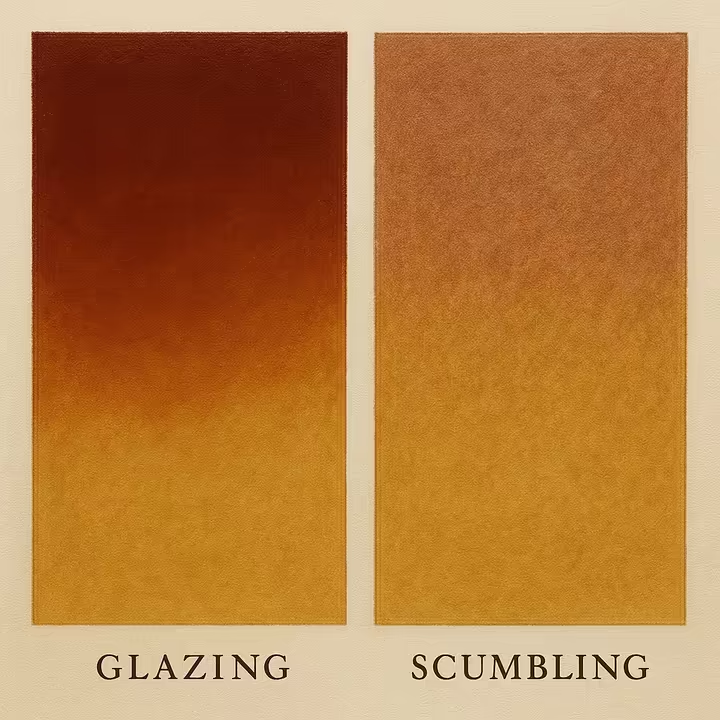
-
Acrylic Painting: Acrylics dry fast and are versatile, good for thin washes or thick textures.
- Wet-on-Wet: Painting new layers while old ones are still wet for soft blends, great for atmospheric backgrounds.173
- Blotting: Applying thick paint then lifting some with a paper towel or sponge for a mottled texture.173
- Pouring: Creating smooth, stroke-free backgrounds by pouring fluid acrylics and tilting.173
- Dry Brushing: Using a dry brush with little paint for subtle textures.173
- Brayer Application/Paint Swiping: Using tools like brayers to apply paint in broad strokes for unique textures.174
- Stamping/Adding Alcohol: Using objects to stamp patterns or dropping alcohol on wet paint for random textures.174
-
Watercolor Painting: Known for its transparency, watercolor excels at luminous, atmospheric backgrounds.
- Washes (Wet-on-Wet/Wet-on-Dry): Applying diluted paint to damp paper (wet-on-wet) for soft gradients (like skies), or to dry paper (wet-on-dry) for sharper shapes.175
- Layering Thin Washes: Building depth by applying multiple transparent layers, letting each dry.175
- Lifting: Removing paint from wet or dry areas to create highlights or soften.175
- Salt, Splattering, Blowing: Sprinkling salt on wet washes for patterns; splattering paint for dynamism; blowing wet paint with a straw for movement.175
- Negative Painting: Painting around the subject to define its edges, good for light subjects on dark backgrounds.175
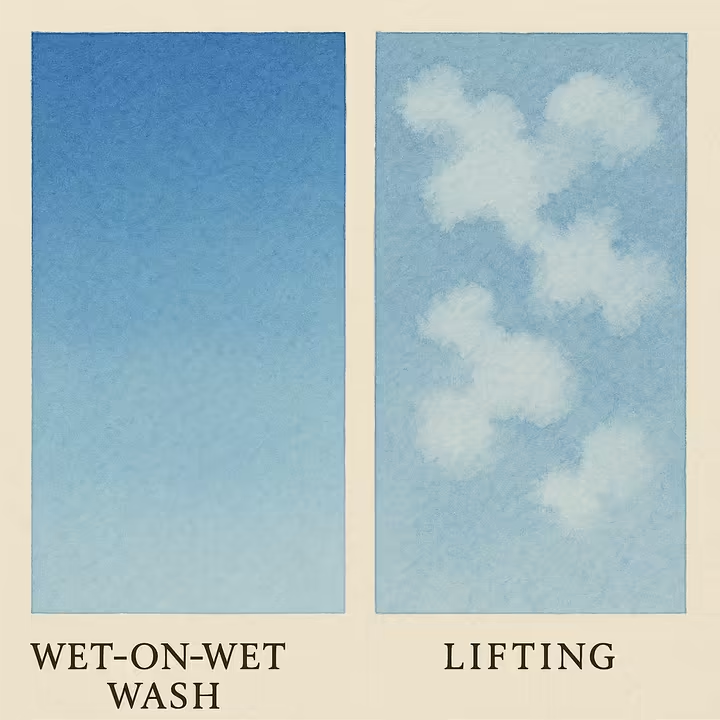
-
Gouache Painting: Gouache is an opaque watercolor with a matte finish, great for layering.
- It can be applied in thin washes like watercolor for initial layers or to provide warm/cool tones.177
- Its opacity means you can layer light over dark or dark over light, allowing corrections.178
- Thicker applications create flat, matte colors or can be used for textures like dry-brushing.177
Choosing a painting technique for a background depends heavily on the paint itself. While basic principles like value contrast apply everywhere, artists adapt them to each medium's unique properties.
For example, watercolor's transparency is perfect for glowing washes and delicate layers, while oil's body allows for rich textures or smooth, blended sfumato effects.
Drawing Backgrounds: Pencils, Charcoal, and Ink
Drawing mediums offer many ways to create backgrounds, from subtle tones to rich textures.
-
Pencil (Graphite and Colored):
- Layering and Blending: Key for smooth tones or textured areas. Multiple colored pencil layers can be blended with tools or by burnishing (heavy pressure with a light pencil) for a waxy finish.179
- Powdered Pigment: Scraping pigment from colored pencils and applying with soft material (like felt) creates very soft, atmospheric backgrounds, good for out-of-focus effects.179
- Solvents: For wax or oil-based colored pencils, solvents can blend pigment for a painterly look.180
- Frisket Film: Masking film protects the main subject while applying broad background treatments, ensuring crisp edges.179
-
Charcoal: A versatile medium for a wide range of tones, from light grays to deep blacks.
- Its powdery nature is easy to manipulate. Stumping (smudging) creates smooth, graduated tones for atmospheric backgrounds or soft shadows.181
- Charcoal is erasable; highlights can be lifted out with a kneaded eraser, creating light effects.181
- It excels at chiaroscuro effects, with strong light/shadow contrasts for depth and drama.181
-
Ink: Offers strong lines and a wide range of values and textures.
- Line Weight Variation: Using different pen nibs or pressure creates varied line thicknesses; thinner lines often for distant background elements.182
- Hatching and Cross-Hatching: Building tones by drawing parallel lines (hatching) or intersecting lines (cross-hatching). Density and direction create shadow and form.183
- Stippling: Creating tones with many small dots. Density determines darkness, good for subtle gradations.183
- Washes: Diluting ink with water and brushing it on creates transparent washes, similar to watercolor, effective for broad tones or atmospheric skies.183
A cool thing about drawing backgrounds, especially with charcoal, is the mix of adding material and taking it away (erasing). This lets artists "draw with light" into darker areas, a different approach than most painting.
Printmaking Backgrounds: Woodcuts, Etchings, and Lithography
In printmaking, the background is tied to the matrix (the plate or block). The background's look comes directly from how the artist worked this matrix.
- Woodcut (Relief Printing): The artist carves wood, removing areas that won't be inked (usually the background). The raised, uncarved surface gets inked and pressed. So, the background is the carved-away space.187 Wood grain can also add texture.
-
Etching (Intaglio Printing): A metal plate is covered with acid-resistant ground. The artist draws through it, exposing metal. Acid bites into these lines. Ink fills the grooves. The background is the unbitten plate, printing as the paper color.187
- Aquatint: A type of etching for tonal areas, often for backgrounds. Resin powder is dusted on the plate; acid bites around it, creating a pitted surface that holds ink for a tone.187 This allows for varied atmospheric effects.
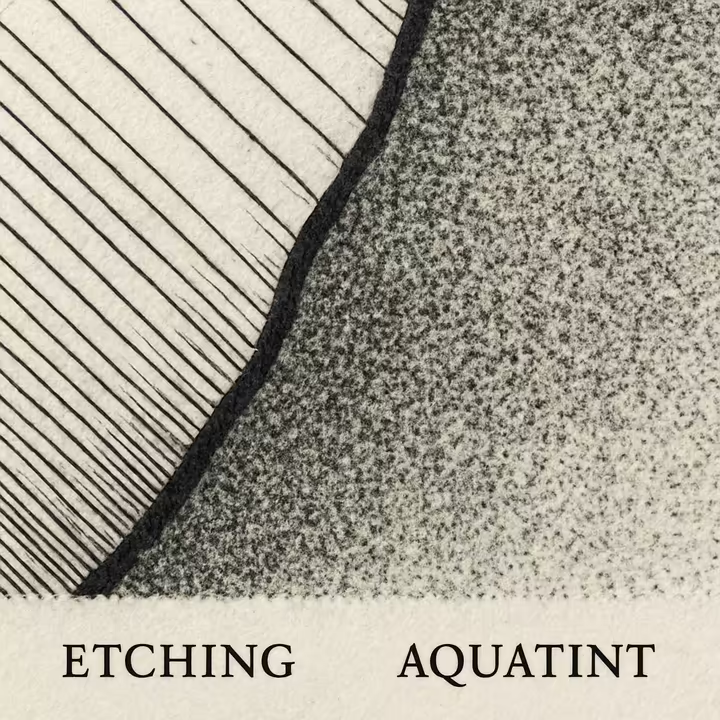
- Lithography (Planographic Printing): The artist draws on a flat stone or plate with greasy crayon. The surface is treated so greasy image areas take ink, while non-image areas (background) repel ink.187 The background is the blank paper.
Creating backgrounds in printmaking is often an indirect process. Unlike directly applying pigment, printmakers often define the background by removing material or treating surfaces to control ink.
This indirectness brings unique challenges and considerations for background design.
Photographic Backgrounds: Depth, Bokeh, and Studio Setups
Photography has its own ways to control backgrounds, mixing optics with physical choices.
-
Depth of Field (DoF): This is the sharp zone in an image. A shallow DoF blurs the background, making the subject "pop."3 DoF is controlled by:
- Aperture: A wider aperture (smaller f-number, e.g., f/1.8) means shallower DoF and more blur.38
- Focal Length: Longer lenses tend to create shallower DoF and more background compression/blur.188
- Subject-to-Background Distance: More distance between subject and background increases blur.188
- Camera-to-Subject Distance: Closer focusing also gives shallower DoF.
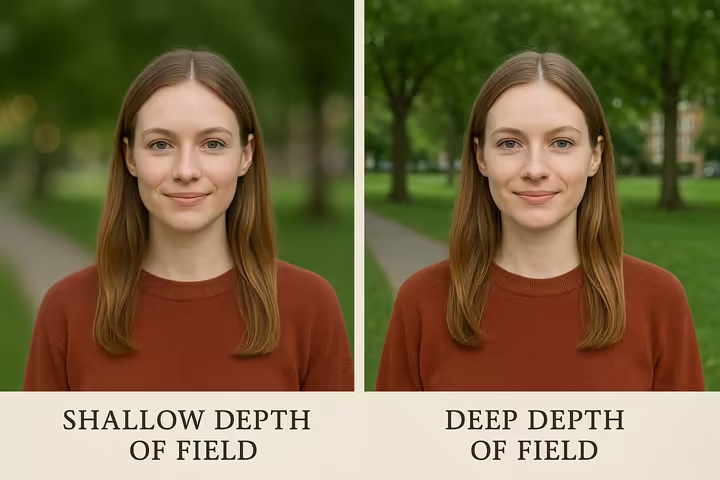
- Bokeh: This Japanese term refers to the visual quality of out-of-focus areas, especially how light points look (e.g., smooth circles).38 Bokeh is influenced by lens design.188 Good bokeh is usually smooth and not distracting.
-
Studio Backdrops: Photographers often use physical backdrops for controlled environments. These include:
- Seamless Paper: Smooth, non-reflective, in many colors, great for clean backgrounds in portraits or product shots.190
- Fabric Backdrops (Muslin, Canvas, Velvet): Offer texture and depth. Muslin is common for casual portraits; hand-painted canvas gives unique effects.190
- Vinyl Backdrops: Durable, waterproof, easy to clean, good for product or food photos.190
- Collapsible Backdrops: Portable, often dual-sided, for on-location or small studios.190
- Printed Backdrops: Feature themes, for specific narrative or branding.190
Photography offers a unique mix: artists can use optics like DoF to transform a real background, or completely replace it with a studio backdrop. This provides a distinct set of creative tools.
Digital Art and Animation: Layers, Models, and Photobashing
Digital tools have revolutionized background creation, offering amazing flexibility.
-
2D Illustration and Animation: Backgrounds set the world, mood, and story. Digital artists use perspective, color, light, and props to build these.149 Common techniques:
- Digital Painting: Using software like Photoshop or Procreate to create backgrounds.149
- Layering: A digital art cornerstone. Layers keep elements separate for easy editing and complex designs.196 "Temp layers" are great for experimenting.197
- Blending Modes: Features like 'Multiply' (for shadows) or 'Screen' (for highlights) alter how layers interact, allowing cool atmospheric effects.149
- Filters and Effects: Tools like Gaussian blur create depth of field or soften backgrounds to direct focus.149
- 3D Modeling: Used for immersive virtual environments in games, animation, and film. This involves building models, then adding textures and lighting.151 Software like Blender is popular for this.199
- Photobashing: Mainly in concept art, artists merge photos, 3D assets, and painted bits to quickly create detailed, realistic backgrounds.201 This speeds up work for complex scenes.
Digital backgrounds are incredibly flexible. Easy iteration, non-destructive editing with layers, and seamless integration of different assets change the speed and complexity of background creation compared to traditional media.
Film, TV, and Games: Sets, CGI, and Environmental Storytelling
In media like film and games, backgrounds (often called environments or sets) are vital for establishing the world and enhancing the story.
- Set Design (Film and Television): This is about creating physical environments, built sets or modified locations, that set the visual style, mood, time period, and character status. Set design works with lighting and costume to tell the story visually.203 Think of the expressionistic sets of The Cabinet of Dr. Caligari or the grand sets for Gone with the Wind.203
- Matte Painting (Film): A visual effects trick to create backgrounds that are too expensive or impossible to build. Historically done on glass, now it's digital, seamlessly blending painted or CGI elements with live-action.158 This is used for set extensions or creating fantasy landscapes, from The Wizard of Oz to Star Wars.158
- Computer-Generated Imagery (CGI) (Film and Animation): CGI is widely used to create and enhance backgrounds, from subtle details to entire virtual worlds.156 It involves 3D modeling, texturing, lighting, and blending digital elements with live-action or in animated scenes.
- Environmental Storytelling (Games): A design approach where story elements are built right into the game's environment. Players find story bits by observing background details, object placement, lighting, and sound.51 This makes the background an active part of the story, encouraging exploration.
Installation, Environmental, and Conceptual Art: When the Environment is the Art
In some contemporary art, the line between artwork and background is deliberately blurred or erased. The environment itself becomes a key part of the art's concept and experience.
- Installation Art: This involves arranging objects in a specific space, where everything, objects and space, is the artwork.139 In site-specific art, the artwork is made for a particular location, making that spot essential.146 Installation art often engages multiple senses.146
- Environmental Art and Land Art: These movements, big in the 1960s-70s, involve making art directly in and with the landscape, often using natural materials.134 Robert Smithson's Spiral Jetty (1970) or Nancy Holt's Sun Tunnels (1973-76) are famous examples where nature is the canvas and medium.141 The art interacts with its environment, often changing over time.145
- Conceptual Art: Here, the idea is more important than the art object.69 The physical form, including any traditional background, might be minimal or non-existent. The "background" could be the social context it critiques, text, or the environment of a performance. For example, Mel Bochner's Measurement Room (1969), where gallery walls were labeled with their dimensions, made the gallery itself the "background" and part of the art's statement.143
In these art forms, the traditional physical background often disappears. It merges with the artwork's concept or site.
The "background" becomes the real world, the specific environment, or the conceptual idea itself, challenging us to rethink art's boundaries.
Emerging Technologies: VR, AR, and AI in Background Creation
New technologies are constantly reshaping how backgrounds are made, offering new tools and ways of thinking for artists.
- Virtual Reality (VR): VR tech allows for fully immersive 3D backgrounds. Artists create 360-degree worlds users can explore, balancing visuals with performance.138 In VR, the background isn't just seen; it's the user's experienced reality.
- Augmented Reality (AR): AR tools overlay digital backgrounds or info onto our real world via devices like smartphones. This blends physical and digital, offering new ways to transform existing spaces.162
- AI-Generated Backgrounds: AI models like Midjourney or DALL·E can create new backgrounds from text prompts or by changing images.164 This empowers users to create visuals quickly but also raises questions about originality, copyright, and artistic skill, especially in commercial fields.164 This introduces the "algorithmic background," where AI mediates creation.
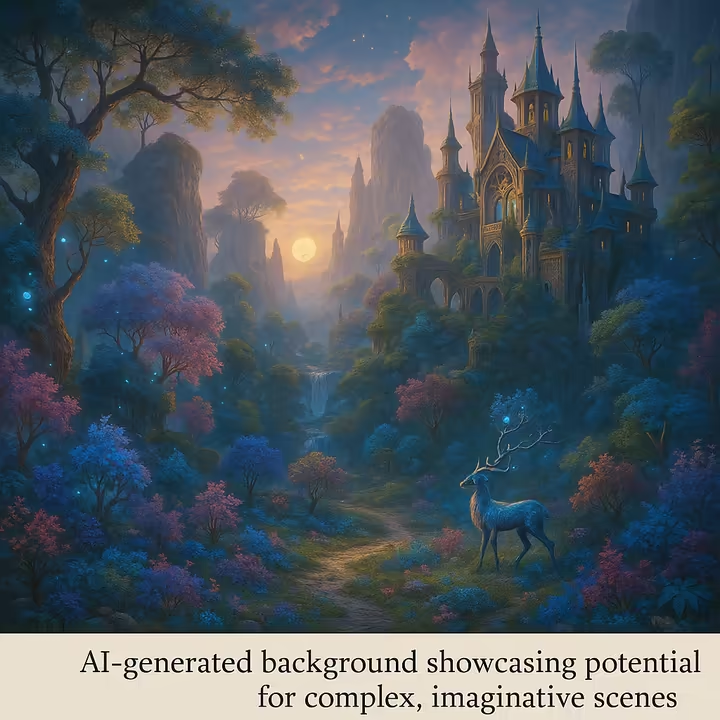
These technologies are pushing what a background can be, moving towards more interactive, immersive, and dynamically generated environments.
The table below offers a quick comparison of background techniques across different art forms:
Table 2: Comparative Analysis of Background Techniques Across Artistic Mediums
| Medium | Specific Techniques for Backgrounds | Key Effects Achieved | Role of Background |
|---|---|---|---|
| Painting (Oil, Acrylic, Watercolor, Gouache) | Layering (imprimatura, underpainting, glazing, scumbling), wet-on-wet, wet-on-dry, washes, dry brushing, blotting, pouring, stippling, use of palette knives, brayers. | Depth, atmosphere, texture, luminosity, mood, color harmony, subject emphasis. | Supportive, Active, Contextual, Atmospheric, Narrative, Symbolic. |
| Drawing (Pencil, Charcoal, Ink) | Layering, blending, burnishing, powdered pigment application, solvents, stumping, erasing, hatching, cross-hatching, line weight variation, ink washes. | Tone, texture, depth, atmosphere, chiaroscuro, form, subject emphasis. | Supportive, Active, Contextual, Atmospheric, Narrative. |
| Printmaking (Woodcut, Etching, Lithography) | Carving (relief), acid-etching (intaglio), aquatint (tonal etching), grease-based drawing on stone/plate (planographic). Matrix design dictates background. | Tonal variation, texture, line quality, flat color areas, contrast. | Integral to print design, defines negative space, contributes to overall composition and texture. |
| Photography | Depth of field manipulation (aperture, focal length, distance), bokeh creation, use of studio backdrops (seamless paper, fabric, vinyl, printed), lighting control. | Subject isolation, background blur, mood creation, contextual setting, clean/controlled environments. | Optical (DoF/bokeh), Physical (studio backdrops), Contextual, Atmospheric, Enhances subject. |
| Digital Art (2D/3D) | Digital painting, layering, blending modes, filters (blur), photobashing, 3D modeling, texturing, lighting, rendering. | Depth, atmosphere, realism, fantasy, texture, mood, non-destructive editing, complex environments. | World-building, Narrative, Immersive, Contextual, Atmospheric, Interactive (in some cases). |
| Film, Television, Games | Set design (physical construction), matte painting (traditional/digital), CGI, environmental storytelling (object placement, level design, lighting, sound). | Realistic/fantastical environments, mood, narrative context, immersion, player/viewer engagement, set extension. | Narrative, Immersive, Interactive, World-Building, Contextual, Atmospheric. |
| Installation/Conceptual/Environmental Art | Site-specificity, use of natural/found materials, incorporation of existing environment, text, performance, dematerialization of object. | Viewer experience, interaction with space/environment, conceptual exploration, social/political commentary. | Often is the artwork itself, or the direct context/concept; redefines traditional background. |
| Emerging Technologies (VR, AR, AI) | 360-degree environment creation, digital overlays on reality, algorithmic content generation. | Immersion, interactivity, blended realities, novel visual styles, rapid generation. | Immersive world, interactive layer, co-created content, tool for ideation/production. |
How Backgrounds Affect Us: The Psychology of Seeing
An artwork's background isn't just a passive backdrop; it actively messes with our brains! It significantly influences how we see, interpret, and feel about art.
Understanding these psychological impacts shows just how important backgrounds truly are.
Figure-Ground Perception and the Power of Negative Space
A basic idea in how we see things is figure-ground perception, a key concept from Gestalt psychology.207 It describes our natural tendency to separate what we see into a "figure" (the main thing that grabs our attention) and a "ground" (the surrounding area or background).207
This happens quickly and often without us realizing it, helping us focus.207 Things like size (bigger things tend to be figures) and contrast (more contrast helps define a figure) play a role.207
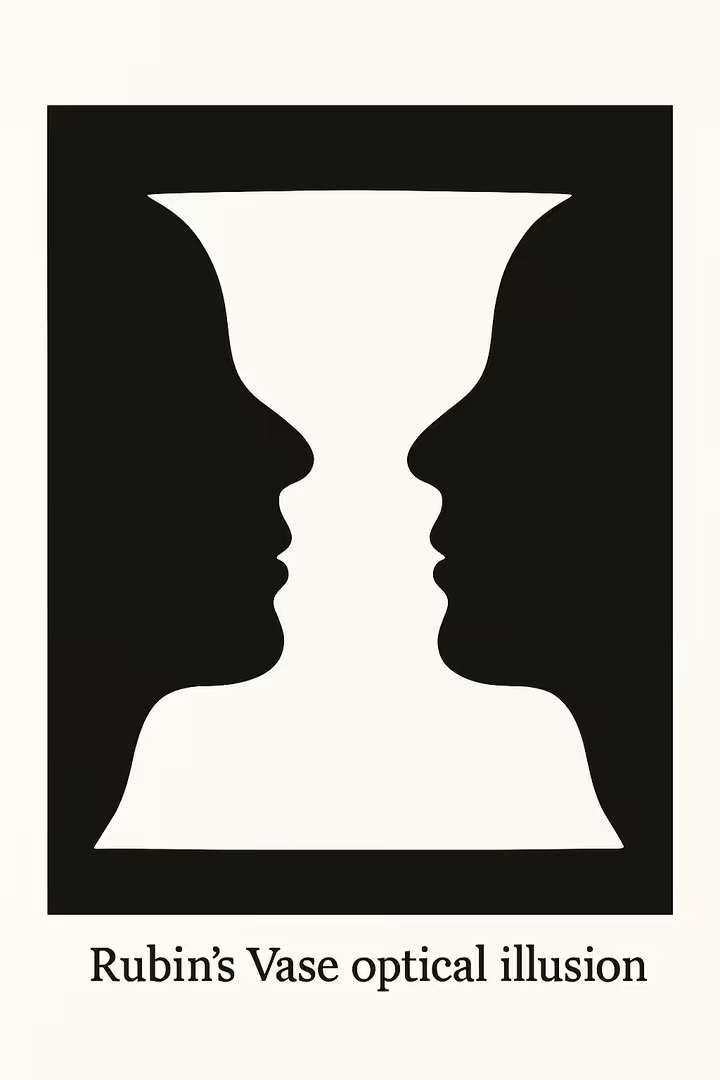
Negative space, the area around and between subjects (positive space), often makes up the ground or background.8 Far from being empty, negative space is crucial:
- Defines the Figure: It gives shape to the subject by outlining its boundaries.8
- Creates Balance: Good use of negative space helps make an artwork feel balanced and harmonious.8
- Provides Visual Rest: It can give our eyes a "place to rest," reducing clutter and making the art more appealing.8
- Forms Shapes: Sometimes, negative space itself forms an interesting shape, becoming an active part of the design, like in Rubin's Vase illusion.8
Artists have always played with figure-ground relationships. Cubists, for example, often broke up the picture so figure and ground merged, challenging how we see.208
This automatic mental sorting means artists can use these tendencies to guide our attention and give meaning even to "empty" parts. That "emptiness" is actually a powerful tool!
How Color, Complexity, and Space Influence Our Feelings
Beyond just figure and ground, specific background traits, like color, complexity, and spatial cues, deeply affect our emotional response and how we interpret art.
Color Psychology is a big one. Background colors can trigger emotions, often from a mix of biology and culture.4 For example:
- Warm colors (reds, oranges, yellows) often link to excitement or energy and tend to pop out.25
- Cool colors (blues, greens, purples) often mean calmness or melancholy and tend to recede.25 Our brains process color, and the emotional bits get linked in through our limbic system.209
The Complexity and Detail Level of a background also affect us.
- Simple, less detailed, or blurred backgrounds can feel calm, focus attention on the subject, or seem dreamy.22 Less background "noise" helps the subject stand out.
- Highly detailed or agitated backgrounds can create energy, tension, or even feel overwhelming if not handled well.4
Spatial Cues in the background, like how depth or openness is shown, really shape our experience.3
- Backgrounds suggesting deep, open space (like with atmospheric perspective) can evoke vastness or freedom.20
- Shallow or enclosed backgrounds might create intimacy or confinement.87
- Depth cues like overlapping or diminishing size help our brains build a 3D interpretation from a 2D image.211
Brain studies show that looking at art engages many brain areas, including those for vision, emotion, reward, and thinking.209 Judging something as beautiful can trigger specific brain activity and feelings.212
Many of these psychological impacts, especially with color and basic spatial cues, work on us subconsciously.210 They shape our initial feelings before we even start to consciously analyze the art.210 However, our overall response is a mix of these low-level features and higher-level thinking, including learned associations and personal experiences.211
Case Studies: Iconic Artworks and Their Masterful Backgrounds
Looking closely at famous artworks shows the amazing ways artists have used backgrounds. These examples highlight how backgrounds add depth, mood, story, and mystery to iconic pieces.
Leonardo da Vinci’s Mona Lisa: A Mysterious Landscape
Leonardo da Vinci's Mona Lisa (c. 1503-1519) is famous not just for that enigmatic smile, but also for its groundbreaking background landscape. This isn't a real place but an imaginative, almost fantasy scene with winding paths, rocks, water, and a distant bridge, all in a hazy atmosphere.5
Leonardo expertly used sfumato, a soft blending technique, to create a smoky, atmospheric quality, especially in the distance, making it look deeper.17 He also pioneered aerial perspective, making far-off elements softer and cooler in color, just like how atmosphere affects our view of distant things.78
Interestingly, the landscape on either side of Mona Lisa doesn't quite line up, and some think Leonardo used multiple, subtly impossible perspectives.80 This carefully built, non-literal environment is level with her eyes, creating a deep visual and psychological link between Lisa and the scenery.78 Many see the landscape as a metaphor for her inner thoughts or a symbol of humanity and nature, a common Renaissance idea. The background is way more than just a setting; it's a pioneering psychological landscape, key to the painting's enduring mystery.5
Johannes Vermeer’s Interiors: Light, Space, and Calm
Johannes Vermeer (1632-1675) is loved for his beautiful paintings of home interiors, which are the main setting, and often, the subject, of most of his work.213 These small paintings, usually with one or two figures in quiet daily activities, are known for their calm mood, clear geometric setup, and amazing rendering of light and texture.213
Vermeer's backgrounds, usually set in his Delft house, are carefully arranged with repeating furniture, maps, and decorative items.214 Though they look real, these interiors are carefully constructed.213 Light, usually streaming from a left-side window, illuminates the scene, creating subtle tones and highlighting varied textures.213 The room's geometry, with tiled floors and straight lines, often adds a strong sense of depth.
The items in Vermeer's backgrounds are often symbolic, hinting at domestic virtues, love, science, or faith, reflecting Dutch Golden Age ideals.213 For example, maps might suggest worldliness, while musical instruments could hint at harmony. In Vermeer's art, the interior background is as important as the people.213 He turns everyday details into scenes of deep stillness and psychological depth, with light making them feel timeless and almost sacred.213
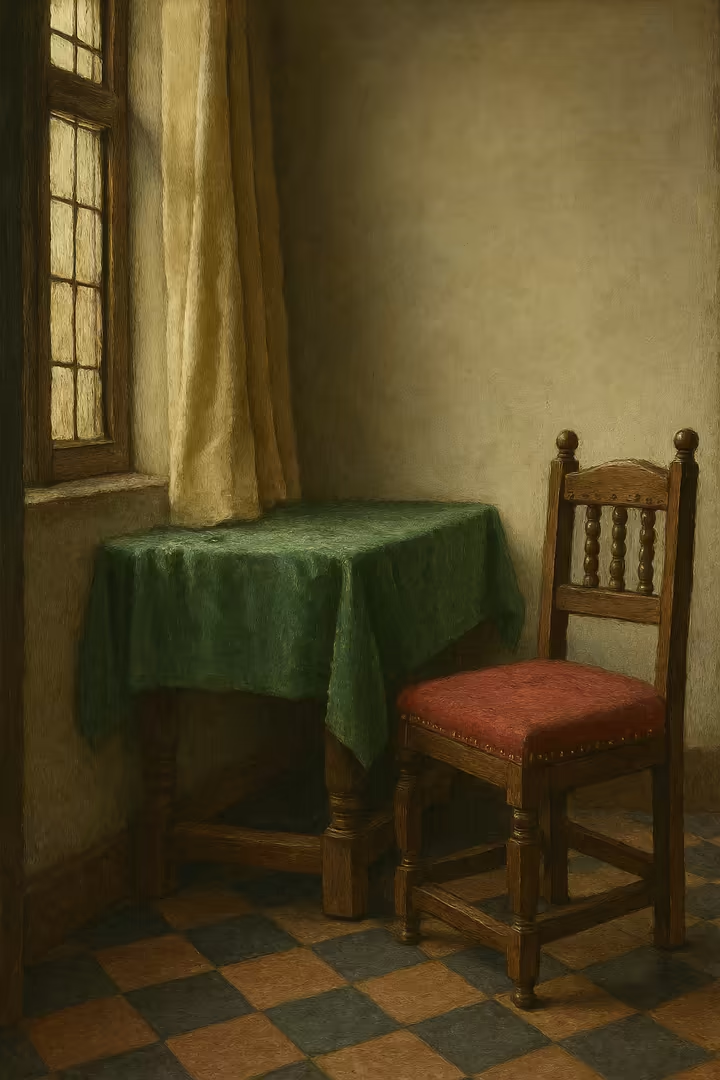
Van Gogh’s Starry Night: Emotional Skies and Cosmic Drama
Vincent van Gogh's Starry Night (1889) is a perfect example of how a background can be the main carrier of emotion and meaning. The painting is dominated by a dynamic, swirling night sky with bright stars and a radiant moon, against deep blues.98
Below this cosmic show is a quiet, dark village, its peace marked by warm window lights.99 A tall, flame-like cypress tree, often linked to death, rises in the left foreground, connecting the earthly village with the turbulent sky.98
Van Gogh used thick paint (impasto), contoured forms, and expressive lines.99 The colors are vivid and symbolic, not natural; the bright yellows and whites of the stars and moon contrast powerfully with the deep blues, suggesting huge energy.99 The sky's swirls are often seen as reflecting Van Gogh's emotional state at the asylum, conveying turmoil and cosmic energy.98 The contrast between the calm village and wild sky can represent peace versus disturbance, both outside and within Van Gogh.98 Yet, the stars might also symbolize hope or his spiritual yearning.98 In Starry Night, the background is an active, raw expression of Van Gogh's inner world.
Mark Rothko’s Color Fields: Where Background and Foreground Merge
Mark Rothko, a big name in Abstract Expressionism, totally changed the relationship between subject, background, and viewer with his Color Field paintings from the late 1940s on.115 In these works, old distinctions between foreground and background mostly vanish.
Rothko's signature style has large canvases with two or three soft-edged, glowing color rectangles, often stacked, seeming to float on or in a contrasting colored ground.120
He did this by applying thin, stained layers of pigment to bare canvas, then multiple thinned oil coatings with quick brushstrokes. This created deep, overlapping colors with hazy edges, making the forms seem to shimmer and hover.120
Rothko wasn't just playing with color; he aimed to express "basic human emotions, tragedy, ecstasy, doom, and so on".120 He wanted his large canvases to wrap around the viewer, creating an intimate, spiritual experience.120 The "background" and "foreground" blend into one color field; color itself is the subject.120 Rothko's paintings offer an immersive background that *is* the whole picture, meant to evoke direct emotional responses.
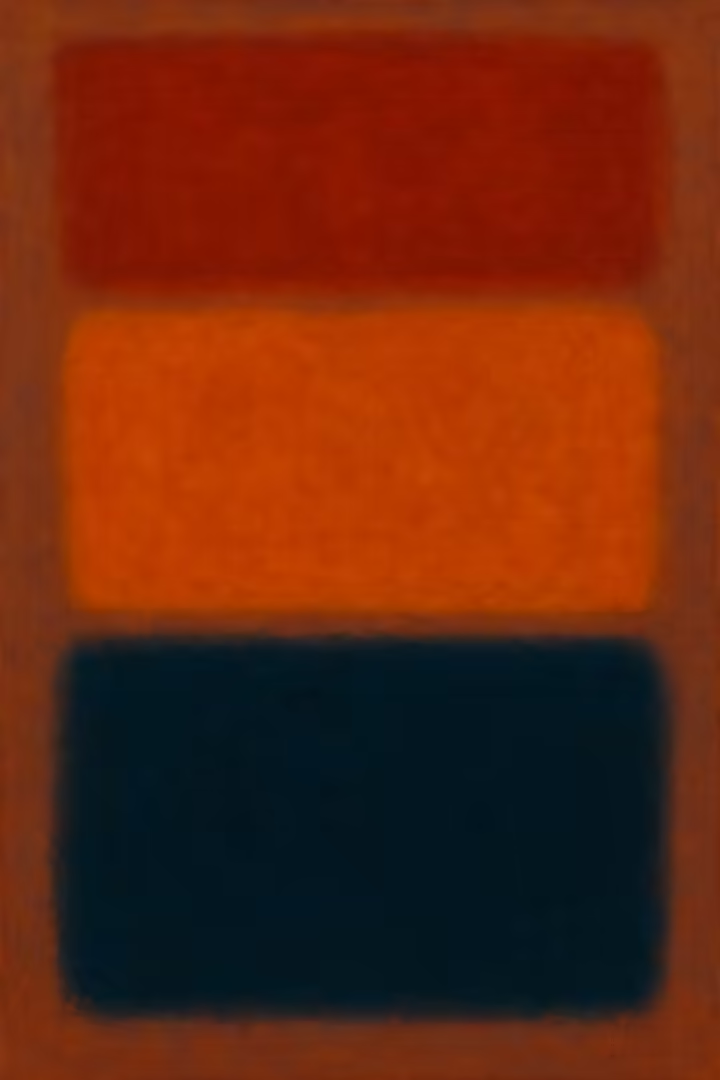
Studio Ghibli’s Animated Worlds: Storytelling Through Environment
Studio Ghibli's animated films, especially Hayao Miyazaki's, are famous for their rich, evocative backgrounds. These play a huge role in environmental storytelling, plot, and themes.
In My Neighbor Totoro (1988), the backgrounds show an idealized, picturesque rural Japan. Lush forests and vibrant landscapes create an imaginative yet real world.215 Nature itself is almost a main character, with bright colors and unique camera angles stressing its beauty.215 The film blends fantasy (like Totoro) seamlessly with this natural setting. These backgrounds are key to themes of family, childhood wonder, and human-nature connection, subtly reflecting Miyazaki's concerns about nature loss due to modernization.215
Spirited Away (2001) uses its backgrounds to explore more complex environmental and social themes. The spirit world's elaborate bathhouse is a fantasy setting that comments on real issues. Characters like the "Stink Spirit" (a polluted River Spirit) directly address environmental damage from human waste.216 The backgrounds in Spirited Away are not just fantasy; they're packed with symbolism about environmentalism, greed, and respecting nature and spirits.216
In both films, the background is more than just a setting. It becomes an active character, a main vehicle for themes, and a source of emotion, showing the power of environmental storytelling in animation.
Looking Ahead: The Enduring Importance and Future of Backgrounds
Our journey through art's backgrounds shows they're way more important than often thought. They're not just empty space but active parts of art that shape how we see, understand, and feel.
How they're treated has always changed, reflecting new artistic visions, cultural shifts, and tech, proving their lasting importance.
Backgrounds do many critical jobs. They set the context (time, place, vibe), create depth illusions, evoke moods with color and light, and enhance or contrast with the main subject to guide our eyes. Often, they carry rich symbolic meanings, adding deeper layers to the story.
Historically, backgrounds have evolved dramatically. Ancient art used them for symbols or early environments. Medieval times saw divine gold grounds or patterned surfaces. The Renaissance brought realistic perspective, turning backgrounds into windows on the world, sometimes even psychological landscapes like in the Mona Lisa. Baroque art used backgrounds for drama, Rococo for elegance, and Neoclassicism for moral stages. Modernism broke all the rules: Impressionism dissolved forms, Cubism fractured space, Surrealism created dreamscapes, and Abstract Expressionism often erased background-foreground lines altogether.
Contemporary art continues this. Hyperrealism pushes detail to extremes. Conceptual and Environmental art might make the site itself the artwork. Digital tech (animation, CGI, games) creates immersive environments. New tech like VR, AR, and AI are pushing boundaries further, turning backgrounds into experienced realities or algorithmically made content. This constant change highlights the background's dynamic nature.
The future of backgrounds will surely be shaped by new tech and artists' evolving ideas. While AI can quickly generate backgrounds, raising questions about originality, the human touch of intention, emotion, and storytelling remains vital.
The most powerful backgrounds, no matter the era or medium, are those thoughtfully designed to serve a clear artistic purpose. The conversation between the subject and the space behind it will keep fueling artistic innovation.
Tips for Creators and Scholars: Working With Backgrounds
Thinking about the background's role, evolution, and how it's made offers great takeaways for both artists and art scholars. Understanding backgrounds can seriously boost art creation and historical insight.
For Artists: Tips for Planning and Creating Effective Backgrounds
A great background isn't an accident; it comes from careful planning and skillful work. Artists in any medium can benefit from these tips:
- Think About It Early and On Purpose: The background shouldn't be a last-minute addition but part of your first idea.4 From the start, consider how it will support your subject, set the mood, tell the story, and guide the viewer's eye.
- Master Composition Basics: A good grasp of design principles, like balance, contrast (value, color, texture), visual hierarchy, and rhythm, is key for making the background work with the foreground.4 The background should help create a unified, impactful piece.
- Get Good with Your Tools: Each medium has its own tricks for backgrounds (as we saw in Section IV). Master these, whether it's layering oils, watercolor washes, digital layers, or depth of field in photos. Quick studies and thumbnail sketches are super helpful for planning.217
- Use Observation and References: Even for fantasy or abstract backgrounds, grounding them in some real observation or good references can make them more believable and impactful.149 Study real light, architecture, or textures.
- Consider the Negative Space: Actively design the negative space your background creates. It's as important as the subject (positive space) for defining forms and balancing the art.8
- Play with Detail and Focus: Not every part of the background needs the same detail. Using atmospheric perspective, selective focus, or simplification can push the background back and keep attention on your focal point.3
For Scholars and Students: How to Analyze and Interpret Backgrounds
To really get an artwork, you often need to look closely at its background. Scholars and students can try these approaches:
- Context is Key: Place the art in its historical, cultural, and artistic setting. How do background norms of that time or culture play out?12 What's new or different? Knowing the artist's world reveals a lot.
- Formal Analysis: Look at the background's formal bits: line, color, shape, space, texture, value. How are they organized? How does the background relate to the foreground and subject? How does it shape the overall look?
- Symbol Sleuthing: Investigate symbols in background elements, objects, figures, landscapes, colors. What do they mean in that cultural context, and how do they enrich the story?44
- Psychological Impact: Think about how background elements (color, complexity, space) might affect the viewer's feelings and interpretation (check Section V). How does it add to the mood?
- Technique and Materials: Examine the methods and materials used. How do these choices affect its look and meaning? Gold leaf in Byzantine icons means something different than gestural paint in Abstract Expressionism.
- Compare and Contrast: Compare backgrounds across different works by the same artist, or within the same movement, or across cultures with similar themes. This can show trends, innovations, and cultural differences.
How backgrounds are made in different times and cultures can be a great historical lens. Shifts in background treatment, from Byzantine gold to Renaissance perspective, or Neoclassical order to Cubist fragmentation, often reflect big changes in worldview, science, beliefs, and values.
So, analyzing backgrounds isn't just about understanding single artworks; it's about deeper insights into art history and human culture.
Why Looking Beyond Art History Helps
To get the fullest picture of backgrounds in art, it's good to look at other fields too. Ideas from outside traditional art history can enrich both art making and interpretation:
- Psychology and Neuroscience: Understanding how we perceive things (like figure-ground) and how our brains react to visuals (like color and space) can help artists make stronger compositions and scholars analyze viewer responses better.209
- Technology Studies: As digital tools, VR, AR, and AI become more common, understanding their capabilities and ethics is key for artists using them and scholars studying modern art.160
- Cultural Studies and Anthropology: These fields can help us understand the specific cultural meanings of background elements in art from around the world.
- Literature and Narrative Theory: For art with strong stories, ideas about narrative structure and environmental storytelling (especially from film and games) can be useful analytical tools.51
By embracing these varied viewpoints, both artists and scholars can keep exploring and appreciating the rich, complex, and always-evolving role of the background in the amazing world of art.
Works cited
- chriswilsonstudio.com, accessed May 27, 2025, https://chriswilsonstudio.com/background-in-art/#:~:text=Background%20in%20art%20refers%20to,to%20create%20interesting%20visual%20effects.
- library.fiveable.me, accessed May 27, 2025, https://library.fiveable.me/key-terms/introduction-art/background#:~:text=In%20art%2C%20the%20background%20refers,viewers%20interpret%20the%20subject%20matter.
- Background - (Drawing I) - Vocab, Definition, Explanations | Fiveable, accessed May 27, 2025, https://library.fiveable.me/key-terms/drawing-foundations/background
- The Role Of Background In Art Composition - Chris Wilson, accessed May 27, 2025, https://chriswilsonstudio.com/background-in-art/
- Genealogies of Modernity , On Background: From the ..., accessed May 27, 2025, https://genealogiesofmodernity.org/journal/2021/3/3/on-background-zoom-and-the-italian-renaissance-portrait
- www.louisvillevisualart.org, accessed May 27, 2025, https://www.louisvillevisualart.org/creative-clues-december#:~:text=Foreground%20is%20the%20space%20of,middle%20part%20of%20our%20composition.
- Foreground, Middle Ground, and Background: A Detailed Guide, accessed May 27, 2025, https://drawpaintacademy.com/foreground-middleground-background/
- Negative space - Wikipedia, accessed May 27, 2025, https://en.wikipedia.org/wiki/Negative_space
- Negative Space in Art: Where Absence Speaks Volumes, accessed May 27, 2025, https://adrianreynolds.ie/negative-space-in-art/
- Why Backgrounds Are Important in Art | Online Art Lessons, accessed May 27, 2025, https://onlineartlessons.com/tutorial/why-backgrounds-are-important-in-art/
- Composition in Art: The Secret Sauce to Captivating Artwork - 21 Draw, accessed May 27, 2025, https://www.21-draw.com/composition-in-art/
- Historical and Cultural Context | Arts and Humanities | Valencia ..., accessed May 27, 2025, https://valenciacollege.edu/academics/departments/arts-humanities-west/writing/historical-cultural.php
- CONTEXT OF ART | PPT - SlideShare, accessed May 27, 2025, https://www.slideshare.net/AnnJunevaLozano/context-of-art-238554199
- The Role of Varied Context in Understanding Art - Arts, Artists, Artwork, accessed May 27, 2025, https://artsartistsartwork.com/the-role-of-varied-context-in-understanding-art/
- Depth, accessed May 27, 2025, http://augustana.net/users/arwalters/design/depth.htm
- 89-OVERLAPPING SHAPES - Painting Lessons With Marla, accessed May 27, 2025, https://paintinglessonswithmarla.com/89-overlapping-shapes/
- Renaissance Art: History, Characteristics, and Examples - 2025 ..., accessed May 27, 2025, https://www.masterclass.com/articles/renaissance-art-guide
- Linear perspective | Definition, Examples, & Facts | Britannica, accessed May 27, 2025, https://www.britannica.com/art/linear-perspective
- Understanding Linear Perspective in Art - Invaluable.com, accessed May 27, 2025, https://www.invaluable.com/blog/understanding-linear-perspective-in-art/
- Atmospheric Perspective · Art Prof, accessed May 27, 2025, https://artprof.org/learn/fundamentals/perpective/atmospheric-perspective/
- Atmospheric perspective | Drawing I Class Notes - Fiveable, accessed May 27, 2025, https://library.fiveable.me/drawing-foundations/unit-7/atmospheric-perspective/study-guide/SwVz977665wbWbQd
- Creating a Sense of Depth and Mood in Your Landscape Paintings ..., accessed May 27, 2025, https://www.chuckblackart.com/blogs/the-painters-block/creating-a-sense-of-depth-and-mood-in-your-landscape-paintings-tips-and-techniques-for-adding-atmosphere
- Painting Awesome Backgrounds | Online Art Lessons, accessed May 27, 2025, https://onlineartlessons.com/tutorial/painting-awesome-backgrounds/
- The Joy of Contrast: Using Opposing Colors and Values to Create Striking Artwork - Altenew, accessed May 27, 2025, https://altenew.com/blogs/the-creative-corner/the-joy-of-contrast-using-opposing-colors-and-values-to-create-striking-artwork
- The Meaning of Colors: How to Use Colors in Your Art , Serena ..., accessed May 27, 2025, https://www.serenaarchetti.com/blog/the-meaning-of-colors-how-to-use-colors-in-your-art
- science of colour - Underpainting in Art to Create Mood - Google Sites, accessed May 27, 2025, https://sites.google.com/site/scienceofcolour/underpainting-in-art-to-create-mood
- The Art of the Mood Board: Crafting Visual Narratives that Captivate Your Clients, accessed May 27, 2025, https://www.theinteriordesigninstitute.com/us/en/blog-the-art-of-the-mood-board-crafting-visual-narratives-that-captivate-your-clients
- How to create a mood board for your art - Alice Sheridan: contemporary artist, accessed May 27, 2025, https://alicesheridan.com/how-to-create-a-mood-board-for-your-art/
- A Beginners Guide to Light & Shadow - Part 1 - Will Kemp Art School, accessed May 27, 2025, https://willkempartschool.com/a-beginners-guide-to-shadow-light-part-1-drawing/
- What is Contrast in Art? Examples and Definition - Artsper Magazine, accessed May 27, 2025, https://blog.artsper.com/en/a-closer-look/contemporary-art/what-is-contrast-in-art-examples-and-definition/
- 8 Examples of Chiaroscuro in Famous Artworks – Naturalist Gallery ..., accessed May 27, 2025, https://naturalist.gallery/blogs/journal/8-examples-of-chiaroscuro-in-famous-artworks
- How to Use Chiaroscuro to Add Depth to Your Artwork – Altenew, accessed May 27, 2025, https://altenew.com/blogs/the-creative-corner/how-to-use-chiaroscuro-to-add-depth-to-your-artwork
- Tenebrism - (Intro to Art) - Vocab, Definition, Explanations | Fiveable ..., accessed May 27, 2025, https://fiveable.me/key-terms/introduction-art/tenebrism
- Technique Tuesdays: Tenebrism - Principle Gallery, accessed May 27, 2025, https://www.principlegallery.com/technique-tuesdays-tenebrism/
- What Is Chiaroscuro in Art? (5 Key Examples) - TheCollector, accessed May 27, 2025, https://www.thecollector.com/what-is-chiaroscuro-in-art-key-examples/
- Baroque: Art, Definition & Style of an Era | Artland Magazine, accessed May 27, 2025, https://magazine.artland.com/baroque-art-definition-style/
- Mastering the Art of Painting Backgrounds for Portraits, accessed May 27, 2025, https://www.paintshots.com/blogs/articles/painting-backgrounds-for-portraits
- Bokeh Mastery in Photography - PRO EDU, accessed May 27, 2025, https://proedu.com/blogs/photography-fundamentals/bokeh-in-photography-creating-beautiful-backgrounds
- How to Add Color Contrast in Acrylic Paintings - paintwithshelby.com, accessed May 27, 2025, https://paintwithshelby.com/2024/09/05/how-to-add-color-contrast-in-acrylic-paintings/
- Visual Hierarchy in Art - Fine Art Tutorials, accessed May 27, 2025, https://finearttutorials.com/guide/visual-hierarchy/
- Visual Hierarchy in Design: 9 Principles of Visual Hierarchy - 2025 - MasterClass, accessed May 27, 2025, https://www.masterclass.com/articles/visual-hierarchy
- 6 Quick Tips to Leading the Eye Through a Painting - Kristen ONeill Art, accessed May 27, 2025, https://kristenoneillart.com/leading-the-eye/
- Techniques for Guiding the Viewer's Eye | Visual Storytelling Class Notes | Fiveable, accessed May 27, 2025, https://library.fiveable.me/visual-storytelling/unit-4/techniques-guiding-viewers-eye/study-guide/O0I0y7KbDaLwd8bf
- Symbolism in Art: Unlocking Hidden Meanings - Arts, Artists, Artwork, accessed May 27, 2025, https://artsartistsartwork.com/symbolism-in-art-unlocking-hidden-meanings/
- Symbolism - The Metropolitan Museum of Art, accessed May 27, 2025, https://www.metmuseum.org/essays/symbolism
- Storytelling in Art - Saint Louis Art Museum, accessed May 27, 2025, https://www.slam.org/teachers-students/virtual-field-trips/storytelling-in-art/
- Narrative Art: What is Your Story? – Collections, accessed May 27, 2025, https://vmfa.museum/learn/resources/narrative-art-story/
- Narrative | Tate, accessed May 27, 2025, https://www.tate.org.uk/art/art-terms/n/narrative
- Tips For Drawing Backgrounds – BAM Animation!, accessed May 27, 2025, https://brentandmax.com/tips-for-drawing-backgrounds/
- Highlight the characters in your drawing with 3 basic tips by ..., accessed May 27, 2025, https://tips.clip-studio.com/en-us/articles/7181
- Environmental Storytelling in Video Games - Game Design Skills, accessed May 27, 2025, https://gamedesignskills.com/game-design/environmental-storytelling/
- Immersive Worlds: How Environmental Storytelling Shapes Gameplay | Gamefa English site, accessed May 27, 2025, https://en.gamefa.com/2824/environmental-storytelling/
- The Basic Principles of Ancient Egyptian Art - Wonderful Things Art, accessed May 27, 2025, https://www.wonderfulthingsart.com/post/ancient-egyptian-art
- Art of ancient Egypt - Wikipedia, accessed May 27, 2025, https://en.wikipedia.org/wiki/Art_of_ancient_Egypt
- The Many Shades of Ancient Egyptian Pigments · Brooklyn Museum, accessed May 27, 2025, https://www.brooklynmuseum.org/stories/ancient-egyptian-pigment-color-analysis
- Greek and Roman art - Students | Britannica Kids | Homework Help, accessed May 27, 2025, https://kids.britannica.com/students/article/Greek-and-Roman-art/274650
- Athenian Vase Painting: Black- and Red-Figure Techniques - The ..., accessed May 27, 2025, https://www.metmuseum.org/essays/athenian-vase-painting-black-and-red-figure-techniques
- Athenian Red-Figure Vase Painting | Department of Classics, accessed May 27, 2025, https://www.colorado.edu/classics/2018/06/15/athenian-red-figure-vase-painting
- Roman Painting - The Metropolitan Museum of Art, accessed May 27, 2025, https://www.metmuseum.org/essays/roman-painting
- Medieval art - Wikipedia, accessed May 27, 2025, https://en.wikipedia.org/wiki/Medieval_art
- DHQ: Digital Humanities Quarterly: The case of the golden ..., accessed May 27, 2025, https://www.digitalhumanities.org/dhq/vol/17/1/000663/000663.html
- Byzantine Art: Mosaics, Icons, and Church Architecture | Intro to Art ..., accessed May 27, 2025, https://library.fiveable.me/introduction-art/unit-3/byzantine-art-mosaics-icons-church-architecture/study-guide/5zHjyqPPHnaGMVhj
- Beginner's guide to Byzantine art & mosaics (article) | Khan Academy, accessed May 27, 2025, https://www.khanacademy.org/humanities/medieval-world/byzantine1/beginners-guide-byzantine/a/byzantine-artintro
- On Goldleafing | Studio Museum in Harlem, accessed May 27, 2025, https://www.studiomuseum.org/magazine/on-goldleafing
- The Symbolism of the Golden Background in Byzantine Mosaics - Archaeology Wiki, accessed May 27, 2025, https://www.archaeology.wiki/blog/issue/the-symbolism-of-the-golden-background-in-byzantine-mosaics/
- www.archaeology.wiki, accessed May 27, 2025, https://www.archaeology.wiki/blog/issue/the-symbolism-of-the-golden-background-in-byzantine-mosaics/#:~:text=Gold%2C%20due%20to%20its%20natural,to%20all%20things%2C%20namely%20God.
- Byzantine Icons: A miracle of Art and Faith - Christianity Art, accessed May 27, 2025, https://www.christianityart.store/blogs/blog/byzantine-icons-a-miracle-of-art-and-faith
- Romanesque art - Wikipedia, accessed May 27, 2025, https://en.wikipedia.org/wiki/Romanesque_art
- Romanesque art | European Architecture & Sculpture | Britannica, accessed May 27, 2025, https://www.britannica.com/art/Romanesque-art
- Romanesque frescoes – The Artistic Adventure of Mankind, accessed May 27, 2025, https://arsartisticadventureofmankind.wordpress.com/tag/romanesque-frescoes/
- Browse all Romanesque Manuscript Facsimile Editions, accessed May 27, 2025, https://www.facsimilefinder.com/browse/style/3-Romanesque
- THE ART OF THE BOOK | viscomhistory - History of Visual Communication, accessed May 27, 2025, https://www.historyofvisualcommunication.com/04-the-art-of-the-book
- Medieval Illuminated Manuscripts - Minneapolis Institute of Art, accessed May 27, 2025, https://new.artsmia.org/programs/teachers-and-students/teaching-the-arts/five-ideas/medieval-illuminated-manuscripts
- Stained Glass Windows: Medieval Art and Religion - ThoughtCo, accessed May 27, 2025, https://www.thoughtco.com/stained-glass-4692208
- French Gothic stained glass windows - Wikipedia, accessed May 27, 2025, https://en.wikipedia.org/wiki/French_Gothic_stained_glass_windows
- Medieval Manuscripts – Decoding The Past, accessed May 27, 2025, https://wugenehong90.wordpress.com/2015/11/04/medieval-manuscripts/
- What is an Illuminated Manuscript? A Painstaking Process, Explained - Invaluable, accessed May 27, 2025, https://www.invaluable.com/blog/illuminated-manuscript/
- The Mona Lisa – Leonardo da Vinci - Analysis - Master Apollon, accessed May 27, 2025, https://masterapollon.com/the-mona-lisa-leonardo-da-vinci/
- Sfumato | Renaissance, Shadowing, Blending | Britannica, accessed May 27, 2025, https://www.britannica.com/art/sfumato
- Mona Lisa – Image Analysis | Leonardo da Vinci - Nico Franz, accessed May 27, 2025, https://nicofranz.art/en/leonardo-da-vinci/mona-lisa
- Baroque painting - Wikipedia, accessed May 27, 2025, https://en.wikipedia.org/wiki/Baroque_painting
- Chiaroscuro and Sfumato - Modern Art Terms and Concepts | TheArtStory, accessed May 27, 2025, https://www.theartstory.org/definition/chiaroscuro-tenebrism-sfumato/
- Rococo | Definition, Art, Painting, Architecture, & Characteristics ..., accessed May 27, 2025, https://www.britannica.com/art/Rococo
- The Rococo Style: What is it and What are its Characteristics? - Berbers Market, accessed May 27, 2025, https://berbersmarket.com/blogs/handmade-moroccan-rugs-encyclopedia/the-rococo-style-what-is-it-and-what-are-its-characteristics
- Rococo - Wikipedia, accessed May 27, 2025, https://en.wikipedia.org/wiki/Rococo
- 10 Artworks That Defined the Rococo Style - Artsy, accessed May 27, 2025, https://www.artsy.net/article/artsy-editorial-10-artworks-defined-rococo-style
- Chapter 14: Rococo and Neoclassical Art - EdTech Books, accessed May 27, 2025, https://open.byu.edu/history_of_the_fine_arts_music/rococo_and_neoclassical_art
- Neoclassicism Art Examples: Timeless Classical Beauty, accessed May 27, 2025, https://russell-collection.com/neoclassicism-art-examples/
- Neoclassical art | History, Characteristics & Artists | Britannica, accessed May 27, 2025, https://www.britannica.com/art/Neoclassicism
- Neoclassicism, an introduction (article) | Khan Academy, accessed May 27, 2025, https://www.khanacademy.org/humanities/renaissance-reformation/rococo-neoclassicism/neo-classicism/a/neoclassicism-an-introduction
- Modern art | EBSCO Research Starters, accessed May 27, 2025, https://www.ebsco.com/research-starters/visual-arts/modern-art
- Impressionism and Post-Impressionism | Oxford Art, accessed May 27, 2025, https://www.oxfordartonline.com/page/1623
- Impressionism Vs Post-Impressionism: What's The Difference? - Pinot's Palette, accessed May 27, 2025, https://www.pinotspalette.com/naperville/blog/creative-life/pinotspalettenaperville-impressionism-vs-post-impressionism-whats-the-difference
- The role of light in impressionist paintings - Canvas Prints Australia, accessed May 27, 2025, https://www.canvasprintsaustralia.net.au/the-role-of-light-in-impressionist-paintings/
- Atmospheric Masterpieces of Impressionist & Modern Art - Sotheby's, accessed May 27, 2025, https://www.sothebys.com/en/articles/atmospheric-masterpieces-of-impressionist-modern-art
- Post-Impressionism: The Bold Evolution of Art - Arts, Artists, Artwork, accessed May 27, 2025, https://artsartistsartwork.com/post-impressionism-the-bold-evolution-of-art/
- Post-Impressionism | explore the art movement that emerged in France - Ilustromania, accessed May 27, 2025, https://www.ilustromania.com/artistic-movements/post-impressionism
- The starry night - myneuronews.com, accessed May 27, 2025, https://myneuronews.com/2024/09/21/the-starry-night/
- Starry Night Analysis | artble.com, accessed May 27, 2025, https://www.artble.com/artists/vincent_van_gogh/paintings/starry_night/more_information/analysis
- Fauvism: The Colorful and Bold Rebellion in Art History - The ..., accessed May 27, 2025, https://artsology.com/blog/2024/05/fauvism-the-colorful-and-bold-rebellion-in-art-history/
- Fauvism vs Expressionism: Key Insights and Comparisons - Wardnasse, accessed May 27, 2025, https://wardnasse.org/fauvism-vs-expressionism/
- Art History II – Renaissance to Modern Era Unit 7 – Expressionism & Fauvism: Bold Colors, Emotions - Fiveable, accessed May 27, 2025, https://library.fiveable.me/art-renaissance-to-modern-times/unit-7
- Fauves In Our Streets - Mister Nicoll, accessed May 27, 2025, http://www.mrnicoll.com/homeclasswork/2020/3/17/fauves-in-our-streets
- Expressionism | Definition, Characteristics, Artists, Music, Theater ..., accessed May 27, 2025, https://www.britannica.com/art/Expressionism
- Expressionism: Channeling Emotion and Turmoil through Art ..., accessed May 27, 2025, https://www.emp-art.com/emp-blog/expressionism-channeling-emotion-and-turmoil-through-art
- Ernst Ludwig Kirchner – Kiama Art Gallery - WordPress.com, accessed May 27, 2025, https://kiamaartgallery.wordpress.com/tag/ernst-ludwig-kirchner/
- Emil Nolde Paintings, Bio, Ideas - The Art Story, accessed May 27, 2025, https://www.theartstory.org/artist/nolde-emil/
- Cubism - The Metropolitan Museum of Art, accessed May 27, 2025, https://www.metmuseum.org/essays/cubism
- Cubism - Art 109 Renaissance to Modern - WordPress.com, accessed May 27, 2025, https://art109textbook.wordpress.com/new-online-textbook-2-2/art-in-the-machine-age/cubism/
- Cubism and multiple perspectives - Smarthistory, accessed May 27, 2025, https://smarthistory.org/cubism-and-multiple-perspectives/
- Surrealism –– Minneapolis Institute of Art, accessed May 27, 2025, https://new.artsmia.org/programs/teachers-and-students/teaching-the-arts/five-ideas/surrealism
- Surrealism - Art That Captures The Imagination - The Artling, accessed May 27, 2025, https://theartling.com/en/artzine/what-is-surrealism/
- Symbolism in surrealism - Mariusz Lewandowski art, accessed May 27, 2025, https://www.lewandowski.art/en_US/n/15
- Surrealism Art Examples: Dreamlike & Strange Creations - Russell Collection, accessed May 27, 2025, https://russell-collection.com/surrealism-art-examples/
- Abstract Expressionism - The Metropolitan Museum of Art, accessed May 27, 2025, https://www.metmuseum.org/essays/abstract-expressionism
- Non Representational Art royalty-free images - Shutterstock, accessed May 27, 2025, https://www.shutterstock.com/search/non-representational-art
- Most Famous Abstract Artworks In The Last 100 Years - The Artling, accessed May 27, 2025, https://theartling.com/en/artzine/famous-abstract-art/
- Abstract Expressionism Movement Overview | TheArtStory, accessed May 27, 2025, https://www.theartstory.org/movement/abstract-expressionism/
- Guide to Abstract Expressionism in Non-Representational Art - Daisie Blog, accessed May 27, 2025, https://blog.daisie.com/guide-to-abstract-expressionism-in-non-representational-art/
- maketolearn.org, accessed May 27, 2025, https://maketolearn.org/wp-content/uploads/2022/09/Color-Field-Paintings.pdf
- Rothko's strokes of white and red - Foyer, accessed May 27, 2025, https://readfoyer.com/article/rothkos-strokes-white-and-red
- Exploring the Interplay: Pop Art, Hyperrealism, and the Art of Figurative Collage, accessed May 27, 2025, https://www.mashgallery.com/exploring-the-interplay-pop-art-hyperrealism-and-the-art-of-figurative-collage/
- Contemporary Art - st‑Art's Amsterdam, accessed May 27, 2025, https://www.st-artamsterdam.com/blog/contemporary-art
- Examples of Hyperrealism Art - Realism Today, accessed May 27, 2025, https://realismtoday.com/examples-of-hyperrealism-art/
- Hyperrealism Art: Where Imagination Meets Reality| 1st Art Gallery, accessed May 27, 2025, https://www.1st-art-gallery.com/article/hyperrealism-art-style/
- The Importance of Backgrounds | Julie Podstolski – Abstract Realism, accessed May 27, 2025, https://juliepodstolski.wordpress.com/the-importance-of-backgrounds/
- The Difficult Distinction between Realism and Hyperrealism in Art ..., accessed May 27, 2025, https://www.artmajeur.com/en/magazine/5-art-history/the-difficult-distinction-between-realism-and-hyperrealism-in-art/335695
- HYPERREALISM - Hoaki Books, accessed May 27, 2025, https://hoaki.com/img/originales/044/obra_44_htatvihq_0b2.pdf
- How do you learn to paint hyper realistic paintings? : r/ArtistLounge - Reddit, accessed May 27, 2025, https://www.reddit.com/r/ArtistLounge/comments/1gnqlja/how_do_you_learn_to_paint_hyper_realistic/
- Drawing as a Way of Seeing - Realism Today, accessed May 27, 2025, https://realismtoday.com/hyperrealistic-charcoal-graphite-realist-drawing-seeing/
- 570 Best Hyperrealism ideas | hyperrealism, realistic paintings, hyper realistic paintings - Pinterest, accessed May 27, 2025, https://za.pinterest.com/rainbowartstudio56/hyperrealism/
- Oil Painting Secrets: Achieving Hyperrealism with Layering ..., accessed May 27, 2025, https://gridmypic.com/blog/20241002_oil-painting-secrets-achieving-hyperrealism-with-layering-techniques/
- Is Hyperrealism an Art Or Skill? - CAROLE A. FEUERMAN, accessed May 27, 2025, https://www.carolefeuerman.com/blog/2020/12/25/is-hyperrealism-an-art-or-skill
- Conceptual art - Tate, accessed May 27, 2025, https://www.tate.org.uk/art/art-terms/c/conceptual-art
- Conceptual art - MoMA, accessed May 27, 2025, https://www.moma.org/collection/terms/conceptual-art
- What is Conceptual Art? Overview with Examples - Sparks Gallery, accessed May 27, 2025, https://sparksgallery.com/learn/what-is-conceptual-art
- A Complete Guide to Concept Art Process + Visual Examples - Pixune Studios, accessed May 27, 2025, https://pixune.com/blog/concept-art-process/
- Environmental Art Movement Overview | TheArtStory, accessed May 27, 2025, https://www.theartstory.org/movement/environmental-art/
- What is Installation Art , Definition, Examples & Artists - StudioBinder, accessed May 27, 2025, https://www.studiobinder.com/blog/what-is-installation-art-definition/
- Do people not get conceptual art because they judge it by the wrong standards? - Reddit, accessed May 27, 2025, https://www.reddit.com/r/ContemporaryArt/comments/s4sqzx/do_people_not_get_conceptual_art_because_they/
- Land art - Tate, accessed May 27, 2025, https://www.tate.org.uk/art/art-terms/l/land-art
- Interactive Art Examples - The Interactive & Immersive HQ, accessed May 27, 2025, https://interactiveimmersive.io/blog/interactive-media/interactive-art-examples/
- Conceptual Art: An Introduction (article) | Khan Academy, accessed May 27, 2025, https://www.khanacademy.org/humanities/art-1010/conceptual-and-performance-art/conceptual-performance/a/conceptual-art-an-introduction
- What Is Conceptual Art: Overview, Examples, and History, accessed May 27, 2025, https://miguelcamarena.com/blogs/news/what-is-conceptual-art-overview-examples-and-history
- What is an Environment Sculpture? - Artmatcher, accessed May 27, 2025, https://www.artmatcher.com/what-is-an-environment-sculpture/
- Installation Art - IMMA - Irish Museum of Modern Art, accessed May 27, 2025, https://imma.ie/what-is-art/series-1-1970-now/installation-art/
- Elements & Principles of Design | Installation Art - Ellen Mueller, accessed May 27, 2025, http://teaching.ellenmueller.com/installation-utopias/resources/elements-principles-of-design/
- Top 10 Land Art and Earthwork Pioneers - Artland Magazine, accessed May 27, 2025, https://magazine.artland.com/top-10-land-art-and-earthwork-pioneers/
- 2D Backgrounds: Create Stunning Scenes for Your Animations ..., accessed May 27, 2025, https://www.skillshare.com/en/classes/2d-backgrounds-create-stunning-scenes-for-your-animations/511370446
- Innovative Techniques for Background Design Animation, accessed May 27, 2025, https://businessofanimation.com/innovative-techniques-for-background-design-animation/
- 3D Environment Design - a Complete Guide | Polydin Studio, accessed May 27, 2025, https://polydin.com/3d-environment-design/
- Background 3D models - Sketchfab, accessed May 27, 2025, https://sketchfab.com/tags/background
- Game Art Design: 12 Principles That You Should Know, accessed May 27, 2025, https://pixune.com/blog/principles-of-game-art-design/
- Design Principles of 3D Modeling | Designblendz, accessed May 27, 2025, https://www.designblendz.com/blog/design-principles-essential-elements-of-3d-modeling
- 10 Examples of Beautiful Computer Generated Art - Artsper Magazine, accessed May 27, 2025, https://blog.artsper.com/en/get-inspired/computer-generated-art-10-artworks/
- What is CGI? How CGI Works in Movies and Animation - StudioBinder, accessed May 27, 2025, https://www.studiobinder.com/blog/what-is-cgi-meaning-definition/
- Computer-generated imagery - Wikipedia, accessed May 27, 2025, https://en.wikipedia.org/wiki/Computer-generated_imagery
- Matte Painting | The Engines of Our Ingenuity, accessed May 27, 2025, https://engines.egr.uh.edu/episode/3105
- History of Matte Painting - Peter Holmes PhD Journal, accessed May 27, 2025, https://pholmesphd.home.blog/2021/12/19/matte-painting/
- Creating Art for Virtual Reality (VR) Games - Pixune Studios, accessed May 27, 2025, https://pixune.com/blog/creating-art-for-virtual-reality-vr-games/
- Game Art and Virtual Reality: Creating Immersive Experiences | RMCAD, accessed May 27, 2025, https://www.rmcad.edu/blog/game-art-and-virtual-reality-creating-immersive-experiences/
- Create Your First AR Artwork - Artivive, accessed May 27, 2025, https://www.artivive.com/resources/create-your-first-ar-artwork
- Artivive: BringArtToLife, accessed May 27, 2025, https://www.artivive.com/
- The Impact of Generative AI Images on the Art World - DEV Community, accessed May 27, 2025, https://dev.to/srihawi/the-impact-of-generative-ai-images-on-the-art-world-2gp6
- The Impact of AI Art in Art Practices - Let's have a moment, shall we? : r/ArtistLounge - Reddit, accessed May 27, 2025, https://www.reddit.com/r/ArtistLounge/comments/1jc5i8u/the_impact_of_ai_art_in_art_practices_lets_have_a/
- Wet into Wet - Mixing Paint on the Canvas - The Virtual Instructor, accessed May 27, 2025, https://thevirtualinstructor.com/blog/wet-into-wet-mixing-paint-on-the-canvas
- Painting the Traditional Way - Part 5 - Final Glazing in Oils - Damian Osborne, accessed May 27, 2025, https://www.damianosborne.com/painting-the-traditional-way-part-5-final-glazing-in-oils
- The Art of Foreground vs. Background: Techniques for Depth ..., accessed May 27, 2025, https://urartstudio.com/the-art-of-foreground-vs-background-techniques-for-depth/
- Brushwork: Techniques, Definition & Examples | StudySmarter, accessed May 27, 2025, https://www.studysmarter.co.uk/explanations/art-and-design/painting-techniques/brushwork/
- The Key To Backgrounds- Oil Painting Tips - YouTube, accessed May 27, 2025, https://m.youtube.com/shorts/X26rnMxzLp0
- www.susanart.com, accessed May 27, 2025, https://www.susanart.com/newsletter-backgrounds/#:~:text=Remember%20warm%20colours%20advance%20in,behind%20your%20main%20foreground%20subject.
- Choosing a Background for Your Painting - Susan Harrison-Tustain Artist, accessed May 27, 2025, https://www.susanart.com/newsletter-backgrounds/
- Acrylic Paint Background Techniques I Nova Color, accessed May 27, 2025, https://novacolorpaint.com/blogs/nova-color/acrylic-paint-background-techniques
- Intimidated by the Blank Page? 5 Acrylic Background Techniques for the Art Journal, accessed May 27, 2025, https://hopalongstudio.com/intimidated-by-the-blank-page-5-acrylic-background-techniques-for-the-art-journal/
- Elevate your Art with Watercolour Backgrounds: beginners to ..., accessed May 27, 2025, https://www.louisedemasi.com/tips/2024/1/19/elevate-your-art-with-watercolor-backgrounds
- How to Add a Watercolour Background to Your Painting - Kerrie Woodhouse, accessed May 27, 2025, https://www.kerriewoodhouse.com/blog/how-to-add-watercolour-background-to-your-painting
- 184. How I Use Gouache - And Why I Love It , Sarah Burns ..., accessed May 27, 2025, https://www.sarahburnsstudio.com/life-of-a-wandering-artist-blog/2022/11/6/184-how-i-use-gouache-and-why-i-love-it
- Flowers using gouache. Do you layer foreground on background color or paint the foreground a d fill the back color? - Reddit, accessed May 27, 2025, https://www.reddit.com/r/Gouache/comments/d9cswi/flowers_using_gouache_do_you_layer_foreground_on/
- Practical Techniques for Creating Coloured Pencil Backgrounds, accessed May 27, 2025, https://www.pencil-topics.co.uk/pencil-backgrounds.html
- 5 Methods for Creating Backgrounds in Colored Pencil Pieces - Ann Richman Art, accessed May 27, 2025, https://annrichmanart.com/blog/5methodsforbackgrounds
- Charcoal | The Metropolitan Museum of Art, accessed May 27, 2025, https://www.metmuseum.org/about-the-met/collection-areas/drawings-and-prints/materials-and-techniques/drawing/charcoal
- 3 Small Things that Remarkably Improve Pen and Ink Backgrounds - YouTube, accessed May 27, 2025, https://www.youtube.com/watch?v=rvYuE2mDrQ4
- 15 Ways to Draw the Illusion of Depth - Ran Art Blog, accessed May 27, 2025, https://ranartblog.com/blogarticle20.html
- 10 techniques to try using acrylic ink – Mont Marte Global, accessed May 27, 2025, https://www.montmarte.com/blogs/tips-techniques/10-techniques-to-try-using-acrylic-ink
- Pen and Ink Drawings - Simple Guide of Cross-Hatching and ..., accessed May 27, 2025, https://artsology.com/blog/2024/05/pen-and-ink-drawings-simple-guide-of-cross-hatching-and-stippling/
- How to Ink a Drawing: 14 Steps (with Pictures) - wikiHow, accessed May 27, 2025, https://www.wikihow.com/Ink-a-Drawing
- What is Printmaking? | A guide to art terminology - Avant Arte, accessed May 27, 2025, https://avantarte.com/glossary/printmaking
- Don't Mistake Depth of Field With Bokeh | Fstoppers, accessed May 27, 2025, https://fstoppers.com/education/dont-mistake-depth-field-bokeh-591026
- Mastering Bokeh in Photography | ProGrade Digital, accessed May 27, 2025, https://progradedigital.com/mastering-bokeh-in-photography/
- Understanding Photography Backdrops: Types & Uses Explained ..., accessed May 27, 2025, https://neewer.com/blogs/blog/photography-backdrop
- Different Types Of Photography Backdrops | 69 drops studios, accessed May 27, 2025, https://www.69dropsstudio.co.uk/blog/photography-backdrops/
- Easy Formula for Painting Simple & Visually Appealing Landscapes | Background Digital Art Tutorial - YouTube, accessed May 27, 2025, https://m.youtube.com/watch?v=3rvwp7vDyxc&pp=ygUTI2F0bW9zcGhlcmljc2NlbmVyeQ%3D%3D
- Paint Your Own Backgrounds in Minutes! | Easy Photoshop Painting - YouTube, accessed May 27, 2025, https://www.youtube.com/watch?v=PDMIv2ik3S4
- Quick Tips ✍️ for Easy Backgrounds in Procreate - YouTube, accessed May 27, 2025, https://www.youtube.com/watch?v=NtgrWywE71c
- Easy Procreate Background Tutorials for Digital Artists - TikTok, accessed May 27, 2025, https://www.tiktok.com/@digital.art.junky/video/7491681129582415146
- The Art of Layering: Tips and Techniques for Building Depth and ..., accessed May 27, 2025, https://altenew.com/blogs/the-creative-corner/the-art-of-layering-tips-and-techniques-for-building-depth-and-dimension-in-your-artwork
- Digital Painting 101 (4 of 5) Layers , Ctrl+Paint - Digital Painting ..., accessed May 27, 2025, https://www.ctrlpaint.com/dp101-4
- Digital Painting Tips - How To Work With Backgrounds - Pencil Kings, accessed May 27, 2025, https://www.pencilkings.com/digital-painting-05-separating-the-head-background/
- Environmental Concept Art & Design - ArtStation, accessed May 27, 2025, https://www.artstation.com/channels/environmental_concept_design
- Using Blender for Illustration/Concept Art References - Reddit, accessed May 27, 2025, https://www.reddit.com/r/blender/comments/1guapt6/using_blender_for_illustrationconcept_art/
- Tried photobashing for the first time, what do you guys think? : r/DigitalArt - Reddit, accessed May 27, 2025, https://www.reddit.com/r/DigitalArt/comments/1h1944e/tried_photobashing_for_the_first_time_what_do_you/
- Digital Painting Tech: Fix for Photobashing – Art & Crit by Eric Wayne, accessed May 27, 2025, https://artofericwayne.com/2019/10/28/digital-painting-tech-fix-for-photobashing/
- What is Set Design? Process & Purpose - StudioBinder, accessed May 27, 2025, https://www.studiobinder.com/blog/what-is-set-design-in-film-definition/
- Tv Show Set Design royalty-free images - Shutterstock, accessed May 27, 2025, https://www.shutterstock.com/search/tv-show-set-design
- Environmental Sculpture: Definition & Types | StudySmarter, accessed May 27, 2025, https://www.studysmarter.co.uk/explanations/art-and-design/sculpture/environmental-sculpture/
- Art as Negation: A Defense of Conceptual Art as Art - OhioLINK, accessed May 27, 2025, https://rave.ohiolink.edu/etdc/view?acc_num=kent1461602608
- What is the Law of Figure-Ground? , updated 2025 | IxDF, accessed May 27, 2025, https://www.interaction-design.org/literature/topics/law-of-figure
- Decoding Artspeak: Figure and Ground - Artsy, accessed May 27, 2025, https://www.artsy.net/article/editorial-decoding-artspeak-figure-and-ground
- The Neuroscience of Creativity: Exploring How Art Affects Mental ..., accessed May 27, 2025, https://www.rmcad.edu/blog/the-neuroscience-of-creativity-exploring-how-art-affects-mental-health-and-cognitive-function/
- The Psychology of Color in Art: Understanding its Emotional Impact - Art Insolite, accessed May 27, 2025, https://www.artinsolite.com/en/post/the-psychology-of-color-in-art-understanding-its-emotional-impact
- The Viewer Responds: Art and Perception | Mount Holyoke College ..., accessed May 27, 2025, https://artmuseum.mtholyoke.edu/virtual-engagement/viewer-responds-art-and-perception
- Emotional Responses to Visual Art and Commercial ... - Frontiers, accessed May 27, 2025, https://www.frontiersin.org/journals/psychology/articles/10.3389/fpsyg.2019.00014/full
- Vermeer and the Dutch Interior - Exhibition - Museo Nacional del ..., accessed May 27, 2025, https://www.museodelprado.es/en/whats-on/exhibition/vermeer-and-the-dutch-interior/462d572e-bbb2-4b22-9f18-9b4e2591dc05
- Johannes Vermeer - Wikipedia, accessed May 27, 2025, https://en.wikipedia.org/wiki/Johannes_Vermeer
- An Imaginative Lens: Analysis of My Neighbor Totoro , Fantasy ..., accessed May 27, 2025, https://www.fantasy-animation.org/current-posts/an-imaginative-lens-analysis-of-my-neighbor-totoro
- "Spirited Away" from Hayao Miyazaki | Stories for Earth, accessed May 27, 2025, https://storiesforearth.com/2019/11/12/episode-3-spirited-away-from-hiyao-miyazaki/
- How To Paint The Background Successfully - How to Pastel, accessed May 27, 2025, https://www.howtopastel.com/2019/01/paint-the-background/
- Category: Workflow - MEGHANN RADER ILLUSTRATION, accessed May 27, 2025, https://www.meghannrader.com/blog/category/workflow
- Design and Composition: Practical Advice for the Advanced Artist - Keene Wilson Fine Art, accessed May 27, 2025, https://www.keenewilson.com/page/6899/design-and-composition-practical-advice-for-the-advanced-artist
- A Comprehensive Guide To Composition For Artists - Draw Paint Academy, accessed May 27, 2025, https://drawpaintacademy.com/understanding-composition-for-artists/
- Mastering Values – The Key to Powerful Acrylic Paintings, accessed May 27, 2025, https://acrylicpaintingwithgingercook.com/mastering-values-the-key-to-powerful-acrylic-paintings/
- Improve your art: Value Study Exercises for Stronger Paintings | Gabriela Shel | Skillshare, accessed May 27, 2025, https://www.skillshare.com/en/classes/improve-your-art-value-study-exercises-for-stronger-paintings/440521834
- Art & Art History Research Guide: Background Research - Seton Hall University Libraries, accessed May 27, 2025, https://library.shu.edu/art/background
- What is art history and where is it going? - Smarthistory, accessed May 27, 2025, https://smarthistory.org/what-is-art-history/